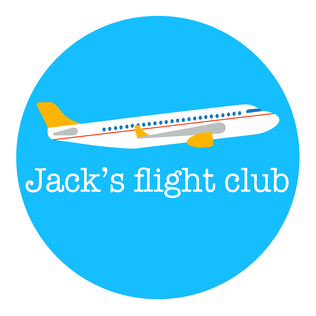Colombia (2-week itinerary)
This trip takes us to across Colombia to Bogota, Salento and Valle de Cocora in Eje Cafetero, Medellín, Guatape, Cartagena, Barranquilla and San Andres Island, but we travelled there in December 2024/January 2025.
TRAVELSOUTH AMERICA
1/11/202559 min read
NOTE: Affiliate links included based on genuine recommendations. Clicking the links will not affect the price you get charged for the service.
Our Itinerary
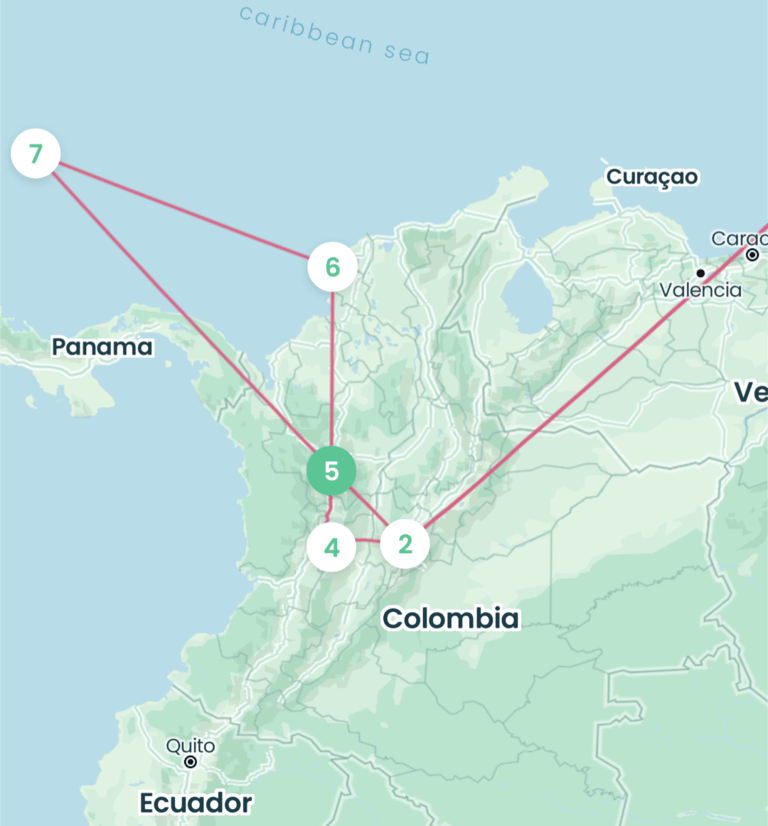

Our main objective for the trip to Colombia was to visit the children I have sponsored from Colombia through Children International. One of them is Loreidis, who is now 26 years old and has two children of her own, but I sponsored her through Children International from the age of 6 until she was 18 years old and we've stayed in touch since. The other one is Emanuel, who I've sponsored from the age of 2 and he's now 16 years old. I met Loreidis last when she was 9 years old, and I was going to be meeting Emanuel for the first time.
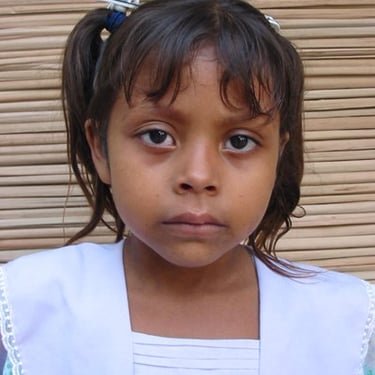
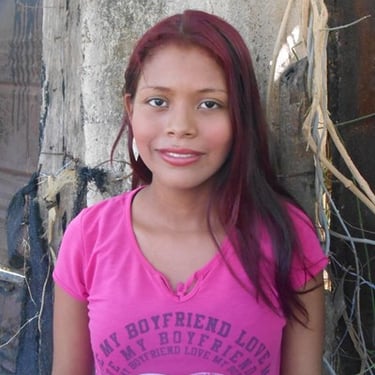
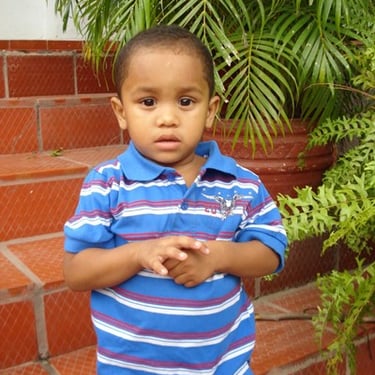

The children I have sponsored in Colombia.
Top left: Loreidis 6 years old, Top right: Loreidis 18 years old.
Bottom left: Emanuel 2 years old, Bottom right: Emanuel 16 years old
However, as we were going to be in Colombia, clearly we were going to make the most of our 2 week long holiday there and see some of the country.
Our trip started in Edinburgh, but we flew with EasyJet from Edinburgh to Madrid where we spent a couple of nights at the Melia Barajas hotel near Barajas airport. We then took an Iberia business class flight from Madrid Barajas direct to Bogota El Dorado airport in Colombia (learn how we did this for just £200 the return flight here) and spent 2 weeks in the country, but our original itinerary included the following:
Bogota (1 night) staying in a hotel near El Dorado airport
Salento (2 nights) staying in an AirBnB flat in the village
Valle de Cocora (daytrip)
Medellin (3 nights) staying in an AirBnB flat in the Laureles area
Cartagena (4 nights) staying in a hotel in the Bocagrande area
Barranquilla (daytrip)
San Andres Island (3 nights) staying in an AirBnB flat in the San Luis area of the island
Bogota (1 night) staying in an AirBnB flat in the La Candelaria area
You can click the place names directly to skip straight to that destination's section.
Preparation for the trip
WEATHER
This is an important one for ANY trip and depends on your personal preference. I'd say most people don't really like to go somewhere during a time when it's raining all the time, as it massively reduces your options for activities and can even be down-right dangerous at times.
Colombia is a tropical country near the equator, so it doesn't have the traditional four seasons like temperate regions. Instead, its weather is influenced by altitude and has two primary seasons: dry season and rainy season.
The dry season is typically from December to March and July to August, with other months classed as rainy season. The mountainous regions can be rainy throughout the year but more so during the rainy season. In the Amazon region, it rains most days.
FLIGHTS
As avid Avios points collectors, we usually try to fly long haul in Business Class, or at least Premium Economy if we are short on points. As bargain rats who are relentless in their pursuit of bargains or discounts when it comes to travel, we also prefer to pay less rather than more when it comes to the taxes and charges as well as points of these Avios redemption flights, which lead us to Iberia. We flew with them in Business Class to Havana, Cuba (read about our trip there here) a couple of years earlier and were going with them again to Colombia this year. Basically, paying for two return Business Class flights cost us about the same in Avios as it would for a single one of the same distance with British Airways (BA). Not only that, but the taxes and charges for these flights are less than HALF of what they are with BA aaaaaand there's way, WAY more reward flight availability with Iberia than there is with British Airways. So it's a win-win-win to use Iberia, even though we needed to fly EasyJet to Madrid first. But we love Madrid anyways (though not Barajas airport!!), so we're always happy to do a stopover. To see our tips for stopovers in Madrid as well as more details on where you can go using Iberia, click here. Be very, very mindful that Barajas airport is absolutely ginoromous, especially Terminal 4 which as yet another terminal within it. This is where most of the Iberia flights go from as well, so arrive really early for your flight, ESPECIALLY if you're planning on checking in luggage. And even if you're not, allow 3 hours at least! Trust me. We almost missed our flights when we were there 2 hours early AND with priority security (due to Business Class tickets.
The flight from Madrid to Bogota took about 10 hours and flying back from Bogota to Madrid took just over 8 hours.
Once in Colombia, we would need to do take internal flights, as buses would have taken us way too long time travelling places. With such limited time on holidays, time was therefore of the essence. Flights were also going to be very much necessary between Cartagena and San Andres Island, as well as San Andres Island back to Bogota.
To get the best flight deals for internal flights, I set up Google Flights alerts for our planned routes on our planned travel dates, so I could keep track on the price patterns and buy when it was cheap. You do this by initially searching your flight route on the day you want on Google Flights. Then, when you get your search results you just scroll down the page to the "Track Prices" section and flick the switch for tracking the date you were looking for. Then Google will send you regular emails advising you about any changes in the flight price.
VISAS AND LANGUAGE
We travelled on Icelandic and Irish passports and neither of us needed a visa to get into Colombia. In fact, that's the case for the vast majority of Latin America, which is why I LOVE travelling there. There's almost never a requirement for a visa, there's generally easy cross-border transport available to travel with buses between countries and you can speak Spanish pretty much the whole way from the US/Mexico border down to the very southernmost tip of Chile and Argentina. Even when I was in Brazil, I could get by using Spanish and the Brazilians spoke to me in Brazilian Portuguese and we made ourselves sufficiently understood to get by.
That being said, I would highly suggest that you try to learn some Spanish before travelling to Colombia. English is very, very rarely spoken but people are very helpful and patient with people who speak little to no Spanish but try their very best. It's not like when you've spent 4 years learning French in school and then go to France and try to speak to people but people have no time for you and have no clue what you're trying to say even if it's their own language you're trying to speak to them in (talking from own experience). In Colombia, they genuinely try their best to understand you and to help you. Knowing a little bit of Spanish before going there goes a long way, and you'll find you'll learn a lot more Spanish being there and having to use the language.
I personally wouldn't bother with programs like Duolingo, unless you're very enthusiastic about finding apples (manzanas) while in Colombia. Duolingo is too slow and too repetitive. Instead, try the Pimsleur Language programme. It's an audiocourse that will massively help you a) understand spoken Spanish, and b) be able to speak Spanish. I have given this advice to numerous friends, and of those who stuck with the programme, they were able to get by using Spanish all across Latin America and made their trip a lot more fulfilling and fun. The audiocourse is very boring, BUT it is extremely effective, I promise.
ACCOMMODATION
As mentioned before, we like collecting Avios and one of the BEST ways to collect them is by booking hotels through websites like Booking.com or Hotels.com via the Avios app portal (learn more about this on our Avios blog here). Doing this usually gives you anywhere between 6 and 12 Avios per £1 GBP spent on accommodation, so if you spend on average say £70 per night and you're away for 14 days, that easily amounts to 6000-12000 Avios earned through the app, plus another 980 to 1470 Avios for the actual spending on an Avios-earning credit card. That's a good chunk towards your news free rewards flight!
However, after doing some research, I found that hotels in Colombia were generally poor value for money. Many of them are pretty run down and are expensive for what they are. Meanwhile, Airbnb offers a much better alternative, especially when you're like us an you like to have a seating area like a sofa to chill at the end of the day. Even a balcony. The issue is that while Airbnb is on the Avios app store, the transactions, I have found, never actually track and even if they did, they only offer a pathetic 2 Avios per £1 GBP spent anyways. But in this instance, the comfort and pricing point outdid the desire for earning Avios for our accommodation, so most of the places we booked were booked through Airbnb. I would generally recommend this approach. Individual reviews of the places we stayed at are found in each destination section.
FOOD
I'm sorry to say, but Colombia isn't the greatest of foodie destinations. Don't get me wrong, there is some great food out there, but by and large, you'll be looking at plantains, beans, yuca, rice and some form of meat that isn't overly exciting and looks a bit like something your 14 year old nephew cooked for you. Very sweet of him, but not quite MasterChef just yet. But to be honest, this is true about a lot of countries surrounding the Caribbean.
There are some interesting Colombian dishes though that are worth trying out in my opinion, especially if you haven't been to Central America, the Caribbean, Colombia or Venezuela before.
Arepas: This is my favourite but just don't order ones that contain chicharrones (bellypork cooked until its hard as glass) - especially if you've got fillings or other dental issues you worry about. These are corn dough pitas of sorts, that are filled with anything under the sky. I love ones with pulled pork, or with chicken, mayonnaise and avocado but I'd eat any, to be honest. Very tasty.
Plantains: For those of you who don't know plantains, they look like bananas but are actually hard and slightly savoury rather than sweet and need to be cooked in order to be eaten. They are actually very tasty and I'd eat it with anything to be honest. They are also used as plantain crisps.
Bandeja Paisa: Literally means "Paisa tray", but "paisas" are the people of the Medellin region. It's Colombia's national dish and is a platter of meat, beans, rice, fried egg, plantains, cornflour arepa without filling, chicharron, avocado, hogao sauce and lemon.
Humitas: This dish is popular in very many places in South America. Its base is a ground corn paste with onions and often the paste is wrapped around a piece of meat, then the whole thing is wrapped into a corn husk and steamed or boiled.
Mojarra: A fried river fish that is found in brackish water. The tasty fish usually comes with a delicious coconut panela rice and patacones, a very traditional Colombian plantain fritters on the side.
There are plenty more dishes, but these are the ones I think are definitely worthwhile tasting while in Colombia.
MONEY
Colombia is generally a pretty cheap country for us coming from the UK.
Cards
We found that were cards were generally accepted, American Express was also accepted along with the major credit cards MasterCard and VISA. However, in smaller places like Salento and San Andres Island, cards were less readily accepted and cash was king. So make sure you have cash on you.
ATMs
The ATMs generally accept foreign bank cards, but they take a hefty commission on top of your own bank fees. The fee is usually a flat fee, so it pays off taking out more money each time. However the amount you can take out is limited each time. For example:
Bancolombia: Maximum withdrawal $600,000 pesos (£113 at time of writing) plus $28,500 pesos withdrawal fee (£5.40)
BBNV: Maximum withdrawal $300,000 (£57 GBP) plus $25,000 withdrawal fee (£4.70).
Davivienda: Maximum withdrawal $500,000 (£94.50 GBP) plus $25,000 withdrawal fee (£4.70).
So you can see you can easily get eaten up by fees pretty fast, where the fees add 5-8% on top of your withdrawal, plus whatever your bank charges you at home. So I would suggest change as much cash at home as you can. Remember: if you're in the UK you'll probably have to pre-order the currency as they don't readily stock Colombian pesos. In the UK, your go-to places would likely be John Lewis or the Post Office.
Prices
Restaurants: If you're eating out at a low to mid-range restaurant, expect to pay around $25,000 to $70,000 pesos (around £4.70-£13 GBP) per dish per person. If it's not a fancy high-end restaurant and they charge you more than that for an average plate of food, they are ripping you off. Walk away. This holds particularly true at beaches where they'll give you special tourist menus with twice the price of what it should cost, while locals get a different menu with different prices. Be particularly wary of this when there are for example cruise ships in town (like happens in Cartagena).
Beers: Buying beers at restaurants was usually around $6000-10,000 pesos (£1.10-1.90) for the bogstandard lager beers. For craft beer, the cost was generally between $10,000 and $20,000 pesos (£1.90-3.80) depending on the volume and how "micro" the brewery was. If buying from the supermarket 6-pack of beer would usually cost us between $10,000 and $20,000 pesos (£1.90-4) depending on whether it was craftbeer or lager.
Taxis: Prices are generally around $15,000-50,000 (around £2.80-9.50) for shorter trips within the cities depending on where you're going. Airports might be more expensive.
Accommodation: We paid between £37 and £82 GBP per night for our accommodation while in Colombia, the most expensive one (£82) being a hotel in Cartagena over the Christmas and New Years holidays. We stayed in Airbnb flats in 4 out of 6 places.
SAFETY
People generally associate Colombia with drugs, violence and murder which comes from the famous narco and guerilla wars waged particularly in the 1980s and 1990s. A LOT has improved since then and many would say that Colombia is safer than many cities in the USA. However, that doesn't mean you should let your guard down. Violence does happen and it's not just affecting those that are involved with drugs and drug trafficking. However, the violence is generally linked to more dangerous neighbourhoods, areas where travellers will rarely find themselves going to. Generally, I'd say the biggest risk to your safety will just be getting from A to B using local transport, as traffic in Colombia is absolutely mental and the rules on the road appear to be the laws of the jungle where people push and shove to get ahead, with added endless beeping of horns. There are generally no seatbelts in taxis or buses.
Below are a few general rules that are good to follow in order to stay safe / not be scammed:
Avoid areas known for being dodgy, particularly at night. But as a tourist, you'll be unlikely to have any reason to go to such areas.
Don't flash your expensive belongings. Dress modestly. Flashing expensive designer clothes, designer bags, fancy watches and the newest iPhone will undoubtetly attract attention of criminals.
Keep a dummy-wallet where you have cash and only one of your cards for your daily spend and the rest elsewhere. In the unlikely event that you get robbed on the street, give them the dummy wallet while all other cards and the rest of your money is safe elsewhere. Never ever resist giving robbers what they want - many have zero respect for life and will kill people if they're not willing to give what they're after.
Avoid poorly lit lonely streets at night anywhere in a big city.
Order taxis via apps rather than getting one off the street. Uber is widely available across Colombian cities. Other apps include DiDi Rider and inDrive, to mention a few. The benefit of this is that it makes the drivers accountable as the order is linked to their name and their vehicle in the event anything happens. These apps, particularly Uber, will also kick drivers with less than ideal rating off the platform. You are a lot more likely to be assaulted or scammed in a taxi that has no accountability, as to you he/she is anonymous.
Avoid getting scammed by not accepting any offers from hustlers on the street or at the beach. Cartagena beach is particularly renowned for this, where women approach you for a massage and then charge you $100 USD for a 5 minute massage, which clearly is a complete ripoff and they know it.
ALWAYS ask and agree on the price ahead of accepting anything, whether it's a service or a product. If you don't, you will get scammed into paying something absurd.
Avoid double-tipping (unless you just want to). When in restaurants, a 10% tip will in 9 cases out of 10 be added to the bill without asking you. Just check your bill for "Propina" or "Servicio". Tipping is not mandatory in Colombia.
GETTING AROUND
Colombia is a massive country and there's loads to see. When travelling between cities, you can either take a bus or fly.
Buses
Buses are very cheap but depending on where you're going, it may be prohibitively time consuming. For example, the bus from Bogota to Cartagena will cost you £57 GBP, but it will also take 23 hours. Meanwhile, if you track your flight prices, you may well be able to get the same leg flying for just £19 (plus luggage charges) and the flight is just 1hr 40min. So personally, we saved the bus journeys for shorter trips (e.g. Pereira to Salento, and Salento to Medellin). Normally it's easy enough to just book your tickets at the bus terminal, but if you need / want to plan ahead, you can buy many bus tickets on the BusBud platform which operates in Colombia, as well as several other countries. BusBud offers services of many different bus companies and the prices are essentially the same as if you booked it at the terminal (minus the faff of having to travel to the terminal to get the ticket). Some bus companies sell tickets online on their own website too, but there isn't any actual benefit of searching out individual companies vs using BusBud.
Flights
There are lots of airlines in Colombia, the most prominent ones with the biggest network of routes being Avianca, LATAM and Wingo. JetSmart and SATENA also cover many routes. To see your options from each of your destinations, I suggest taking a look at the FlightConnections website, which is absolutely EXCELLENT to help you plan your route. I use it ALL THE TIME. If you track your planned flight routes and destinations using Google Flights, you'll be bound to get a great deal on your flights.
One thing to note is that for some bizarre reason, the Colombian websites often don't like foreign cards. It caused me A LOT OF frustration when trying to book flights for our holiday and I know from speaking to others that we weren't the only ones experiencing this issue. The easiest workaround was a) Book on the British version of the site which was a lot more expensive, or b) Book on a third-party website like Kiwi.com which worked perfectly.
Taxis
Taxis in Colombia are REALLY cheap. I won't even try to recommend trying to navigate the local transport system in cities here, because for the amount of hassle vs the price of taking an Uber, we took an Uber every single time, no questions asked. The local trips within a city lasting 10-20min usually cost between £3-10 GBP, depending on surge pricing and the distance. There are lots of different platforms but the taxi drivers tend to just be on all of them. The ones that kept getting recommended were Uber and InDrive.
We once took an Uber between cities too, as we needed to be in Barranquilla for 9am visit at Children International, travelling from Cartagena. That trip cost us £75 GBP (just under $400,000 pesos) one way for the 2.5hrs journey between the two cities. The taxi driver then saw his chance to make money on his way back home so he worked in Barranquilla during the day and then offered to take us back to Cartagena for $300,000 (£56).
CONNECTIVITY
We were conveniently connected to the world upon landing in Bogota El Dorado airport as I had installed an Airalo eSIM prior to leaving the UK. This was extremely useful and I highly recommend doing this for wherever you're going if your phone supports the use of eSIM. We both use Google Pixel and it works perfectly on both phones which are different versions. There are lots of different eSIM companies out there but we have used Airalo in Japan in 2023, we got a regional eSIM for Southeast Asia in January 2024 which worked wonders when crossing multiple land borders on one trip and this time in Colombia. It works great.
At the time of writing, the 3GB data package valid for 30 days cost £9.50 but you can get £2.50 GBP off if you use our referral code THRUDU0108 when you sign up or check out using the following link: https://ref.airalo.com/Qqdi
I also get £2.50 off my next purchase if you do, so thank you for using my referral link!
Arriving in Bogota
We arrived in Bogota in the late afternoon and knew we'd be tired after a long-haul flight which is why we booked ourselves into a hotel near the airport for one night before continuing our journey to Salento in Colombia's coffee country.
Arriving in Bogota was pretty straight forward but we immediately regretted having checked in our handluggage bags. It seemed tempting to ditch the bags at the time, but then once in Bogota there was a very long wait for bags to turn up on the conveyor belt. If we had just taken them with us, we'd have saved ourselves a lot of time and hassle, walking straight off the plane and gone to our hotel.
The hotel we has booked was the Hampton by Hilton in Salitre which cost us £49 GBP per night including breakfast for the two of us as well as (alledged) free airport shuttle. The shuttle was one of the big selling points for us. They claim it goes every 30 min from the airport as published on their website, but is actually (allegedly) every 45 min. They also don't tell you where to take the shuttle, not on their website nor booking platform. We did figure out eventually where the shuttles go - earlier in the year it was going from Door 5 after exiting the Arrivals hall, but had now been moved to Door 1 on the ground floor. We however never saw one for this hotel, just other hotels, so we ended up taking a taxi which was $25,000 (£4.53) for a yellow taxi from the airport.
Personally, we wouldn't particularly recommend this hotel. While its breakfast is excellent and the views from the top floor is excellent, that's pretty much where it ends. The airport shuttle is not to be relied upon either, as we ended having to take a taxi back to the airport the next morning as well.
Salento in the Colombian Coffee Country
The next morning we took a taxi from our hotel in Bogota to the airport and flew with Avianca to Pereira, en route to the village of Salento, located in the Quindío department of Colombia. You can also get to Salento by flying to the city of Armenia but due to the airport location in Armenia, it's a bit shorter distance from Pereira.
The flight was on time and we went out to get an Uber that would take us to Pereira Bus Terminal which cost us $15,000 pesos (£2.80).
As we walked into the bus terminal, we just walked up to the next booth selling tickets to Salento which ended up being with a company called Alcala (AVOID!!) and the one way bus fare was $11,500 pesos (£2.15 GBP) per person to Salento. What we did not know until we were on the bus that there was absolutely no space for our luggage, so we had to carry it on board and the bus was absolutely crammed full. It was horribly uncomfortable and many of the windows were spraypainted black so there was no view but fortunately the trip is only just under an hour. If we had decided to take a taxi, the Uber driver that picked us up at the airport said he could take us for $170,000-180,000 (£32-34 GBP) from there to Salento, but I had already decided that we'd try to save our money and just pay £7.20 in total for the taxi to the bus station and the bus fares. It was a bit uncomfortable, but the $130,000 pesos or so saved would get us at least a couple decent meals and drinks in Colombia.
Why Salento?
Salento is a charming and picturesque town known for its coffee culture, stunning landscapes and traditional architecture which reflects the region’s rich history and traditional lifestyle. It lies within Colombia’s famed “Coffee Triangle” (Eje Cafetero), a UNESCO World Heritage site surrounded by lush coffee plantations where visitors can tour fincas (coffee farms) to learn about coffee cultivation and processing. The village itself is known for its colorful, colonial-style buildings with intricate wooden balconies and doors. Salento’s laid-back vibe makes it an ideal place to unwind. Most people come here to visit the Valle de Cocora, a valley near Salento famous for its giant Quindio wax palm but there's plenty more to do here.
The AirBnB we had booked for the next couple of days was located just a couple of blocks from the bus station in Salento, so we headed there to check in, which was an aparthotel called La Marteja located on Calle 7 on the corner with Carrera 3. While the house looked lovely on the outside and when walking into the flat, it all looked cozy, it actually didn't end up being a particularly nice place to stay as the flat faces the road and it gets terribly noisy at night and the house has no sound insulation whatsoever. On top of that, the owner's neighbour has a dog that barks relentlessly right beneath the flat. The flat itself wasn't great either as the cooking facilities were very basic, the only source of hot water was from the shower so dishes needed washed with shower water and the coffee machine had clearly not been cleaned for weeks as it was crawling with mould. For those reasons, I wouldn't particularly recommend this place, which actually ended up being the worst accommodation we had in all of Colombia. Which was a wee shame, cause it looked so very charming from the pictures.
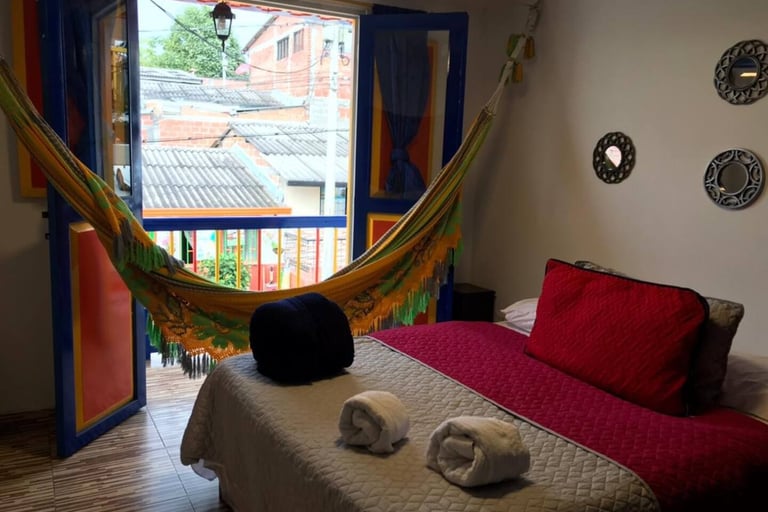

Photographs of accommodation can be deceiving
We were very unlucky with the weather, as there was torrential rain when we arrived in Salento and throughout much of the day and night with scattered thunderstorms. With this wet climate, we were also surprised to find that it is actually remarkably hard to find an umbrella for sale in Salento! So a tip for people coming here: Bring your own foldable umbrella, as the only ones sold in Colombia appear to be the really big ones you can't easily pack into a suitcase, or there just isn't any at all! As we didn't have means of protecting ourselves from such extreme rain (aside from basic rain jackets - also recommend packing!), we largely just sayed indoors on the first day. However, there are some indoor activities to be had in Salento!
Playing a game of Tejo
Tejo is a traditional Colombian sport that combines skill, strategy, and a dose of explosive excitement. It's considered Colombia's national game and has been played for centuries. It is traditionally played in social settings, such as bars, community centers, or dedicated tejo courts, often accompanied by music, food and drinks like beer. The game traces back to the indigenous Muisca people, who played a version of tejo using gold discs (called "zepguagoscua") and rocks. The modern version evolved with the addition of clay, gunpowder and metal.
The Basics of Tejo
Objective:
The goal is to throw a metal disc, called a tejo, onto a board covered in clay and hit targets called mechas, which are small paper packets filled with gunpowder and arranged around a metal ring called bocin. Hitting a mecha creates a loud explosion, making the game exciting and competitive.
Points are scored based on accuracy and hitting specific targets..
How to Play:
Players stand at a fixed distance from the clay board and take turns throwing the tejo.
The goal is to hit the mechas for an explosion or land the tejo within or near the bocin for points.
The game can be played individually or in teams.
Scoring in Tejo:
Points are awarded as follows:
1 Point: The tejo lands close to the bocin.
3 Points (Mecha): Hitting a mecha, causing an explosion.
6 Points (Embocinada): The tejo lands directly in the bocin.
9 Points (Moñona): Landing the tejo in the bocin while also hitting a mecha.
Whoever gets 21 points first wins!
In Salento, you can have a go at playing authentic Tejo at Cancha de Tejo Los Amigos on Carrera 4 between Calle 3 and Calle 4. The game costs $14,000 pesos (£2.65) per person, which includes a beer. Great fun when passing the time while it's raining!
Food
Some of the best food we had in Colombia we had in Salento. There are a few typical dishes that are popular:
Trucha al Ajillo (Garlic Trout): One of Salento’s signature dishes is fresh trout, often served with fried plantains or patacones. Many local restaurants specialize in this dish.
Arepas and Empanadas: You’ll also find traditional Colombian snacks served in local eateries.
Coffee Shops: Salento has a vibrant coffee scene, with cozy cafes serving locally grown, freshly brewed coffee.
Our recommendations of places we tried out during our short stay in Salento include:
Restaurante La Gata Carola, Salento.
We had a delicious tropical burger here with a sort of a pineapple relish for £25,000 each, and craftbeer for $8000 each. Their burger was on par or better than any smash burger you'd have in the UK. Stunning. Yum. If we had stayed longer in Salento I would have come back for more.
Arepas Manaos, Salento.
This place is located within a downstairs food court at the southeastern corner of Plaza de Bolivar. It's easily missed as the food court is hidden. You'd be most likely to spot it when walking up Carrera 7 as you approach the plaza. This place sells delicious arepas but we got the more up-market ones that cost $16,000 pesos and $20,000 respectively, with small cans of beers going for $6,000 pesos each. Again, I would definitely have been a repeat customer here if we had had the time!
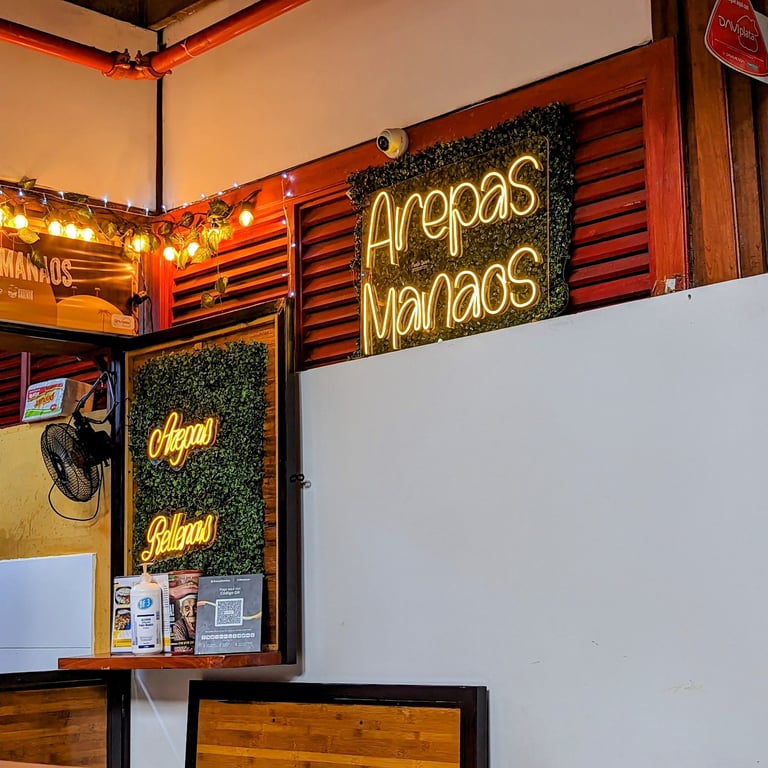
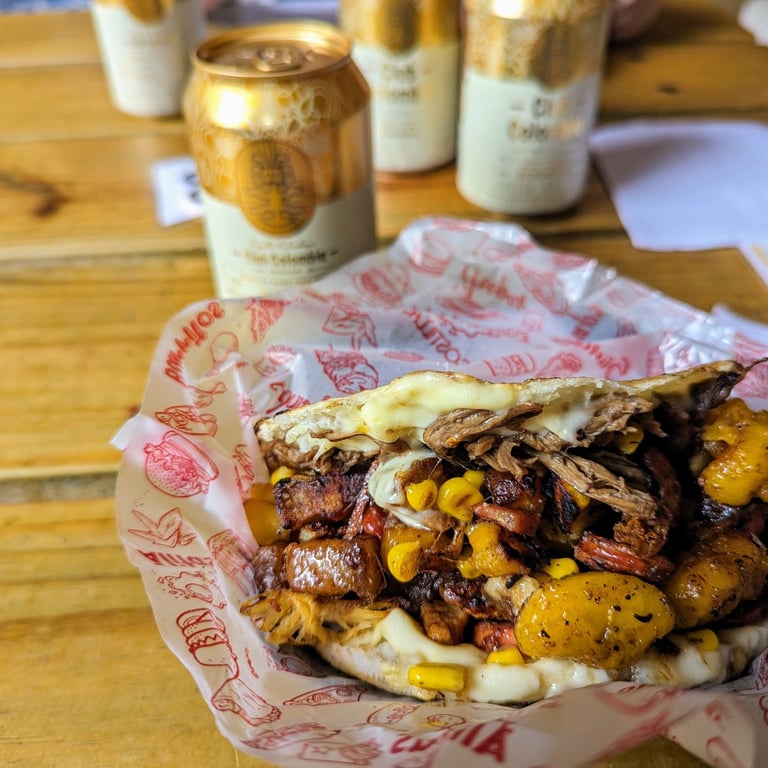
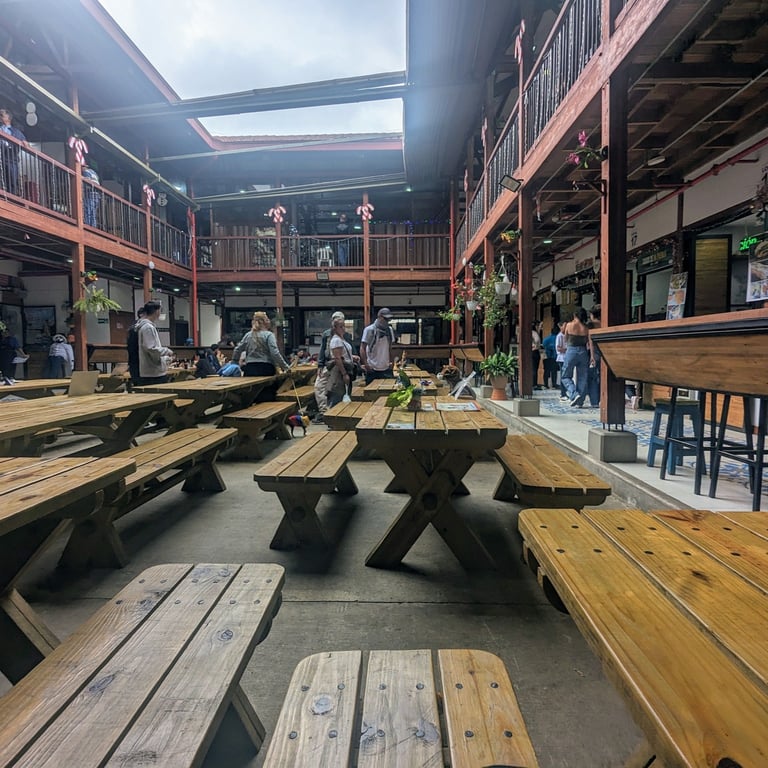
On our second day in Salento, the weather improved a fair bit, though it was occasionally drizzly. But it cleared enough to have a bit of a walk around town.
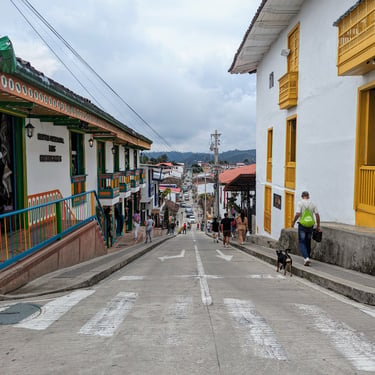
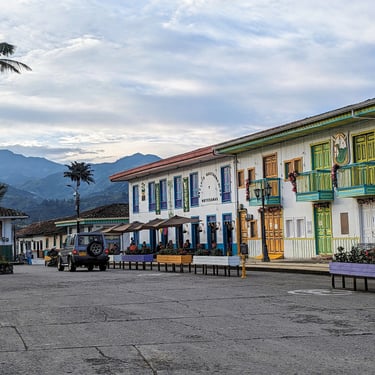
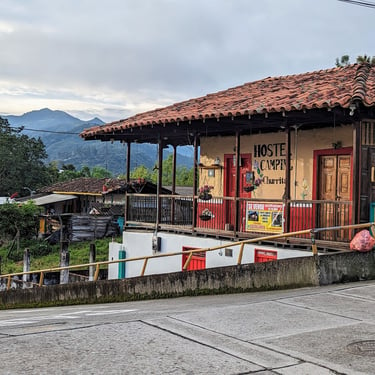
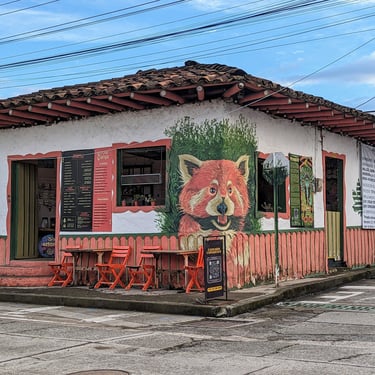
We only stayed 2 nights in Salento, but it would have been very easy to spend several more days in here and see some more of the surrounding area. Some of the things we would have liked to have had the opportunity to do but didn't have the time or opportunity include:
Doing a coffee tour (for example the Luger tour for $45,000 pesos)
Climb to the viewpoint of Salento
Visit the nearby village of Filandia
Visit the thermal pools at Termales Santa Rosa de Cabal
Visit the De Olier Chocolatl chocolatemakers and getting a 2hr lesson in making our own chocolate for $96,700
Unfortunately, our time was limited and we already had accommodation booked in Medellin. We got our Salento to Medellin tickets from the Occidental bus company at the Salento Bus Terminal the day before travelling but I can't for the life of me remember how much it was - I think it was around $80,000 pesos per person?
Valle de Cocora
The Cocora Valley is one of the main reasons why people come to Salento, as the valley is pretty much on the village's doorstep. The valley is home to the impressive giant Quindío wax palm, Colombia’s national tree and the tallest palm tree in the world. These palms can grow up to 60 meters (200 feet) tall and are set against a backdrop of lush green hills and misty mountains. The region is also a hotspot for birdwatchers, with species like hummingbirds and toucans commonly spotted. The Acaime Reserve, where you find the House of the Hummingbirds in Cocora Valley is a favorite destination for bird enthusiasts.
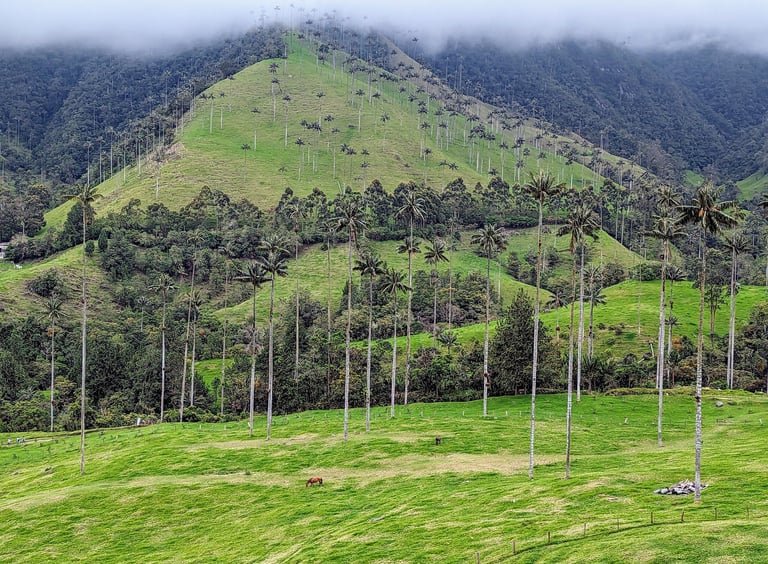

To get to the Cocora Valley, you walk to the main square in Salento (Plaza de Bolivar) where you'll find the Willys jeeps waiting to take passengers to the valley from around 6am in the morning. There's a ticket booth in the same place where you pay $9,000 pesos for the return ticket (keep your return ticket safe!). They then fill the next jeep due to go absolutely to the brink. There are a couple of seats next to the driver, but on the pick-up itself they've installed seats that have spaces for 3 people on each bench, plus three people hanging from the back of the jeep, so a total of around 11 passengers per Willys jeep. They order women to board first, who usually get a seat, and then the men who often draw the short stick and have to hang from the back of the Willys jeep.
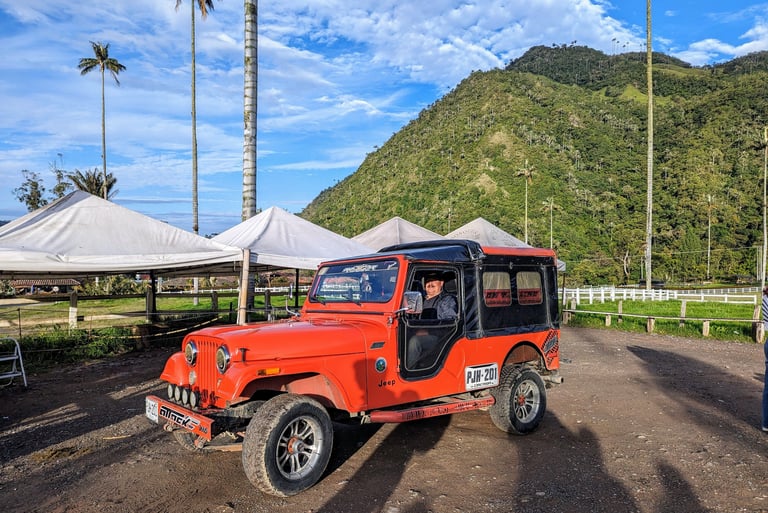

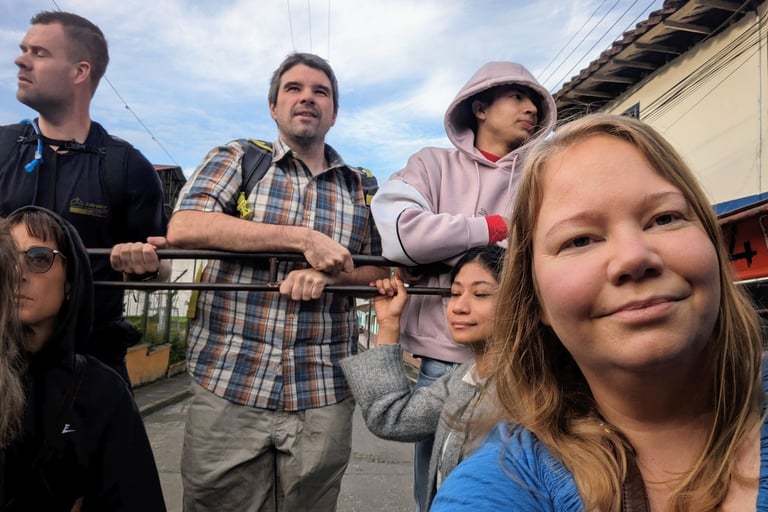

Men often end up having to hang at the back of the jeep on the way from Salento to the Cocora Valley
The mode of transport getting to Valle de Cocora
The journey from Salento to the Cocora Valley takes around 30min. The drop-off point is in front of the "Donde Kike Cocora" restaurant (as marked on Google Maps). The drop-off point used by the Willys jeeps is the same place you have to go when going back to Salento. The car park is just steps away from where the main loop trail starts. You can choose to do the trek clockwise or anticlockwise. We used the free version of the AllTrails app to follow the "Cocora Valley - Acaime" path so that we wouldn't get lost. That way you can also track how far you've come, see the change in elevation etc.
The circular trail is 9.8km long, but if you want to go to the House of the Hummingbirds, it's another 1.1km (so a total of 10.9km). We skipped the Hummingbird House as the trek was long enough as it was, I am not a fit person and on top of that, there's an additional fee of $25,000 pesos per person to go there. Aside from the fee for the Hummingbird House, you need to pay entrace fees at two checkpoints: $6,000 pesos on the southern section and another $20,000 pesos on the northern section, which can only be in cash so make sure you bring some to avoid disappointment.
The elevation gain along the loop is 559m, so it's definitely a proper trek and it's not easy. But not just that, but the trek actuallly starts at 2428m above sea level. That's higher than the highest mountain in Iceland and almost twice the height of Ben Nevis, highest mountain in the UK. So be sure to be acclimatised to the higher elevation. If doing the trek anticlockwise as we did, you start by taking the path to the right going down to 2370masl and follow the path of the river. But then it's a very quick and steep climb up through the cloudforest to 2929m. From there, the walk becomes a lot more pleasant - mostly flat but slowly going down, until you reach the end which is a fairly quick downhill walk. Most people do the trek clockwise, as it takes you to the main sights pretty quickly with all the viewpoints and quirky "instagrammable spots" but we went for anticlockwise. I'm not sure if it was a good choice or not, as by the time we got to the other side, the place was absolutely rammed with people. SO MANY PEOPLE. However, we enjoyed the forest and the views in complete solitude for the first half of the trek, seeing almost no one for whole 2 hours. Also, while I am absolutely hopeless at uphill trekking, I am SO out of shape, I think that the descend would be even trickier.
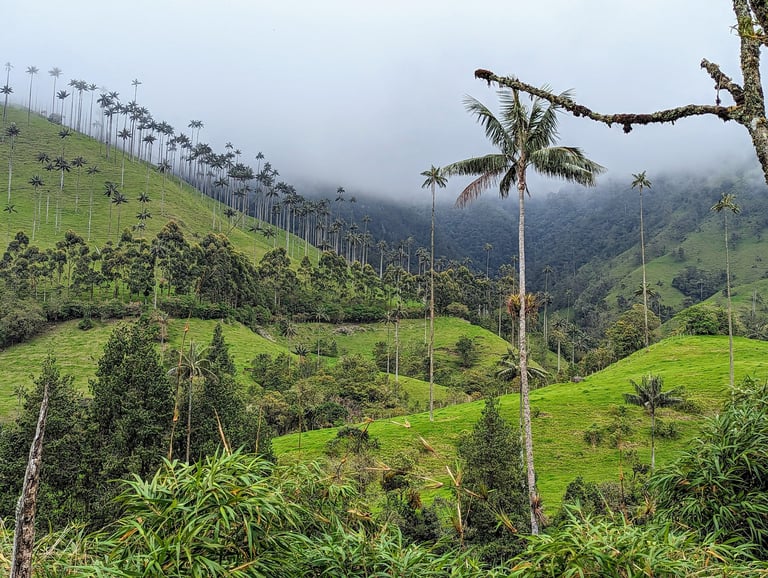
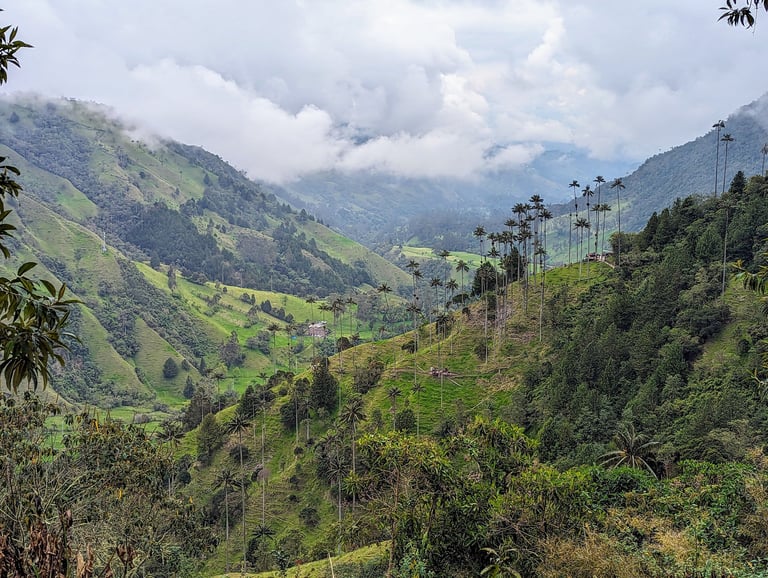
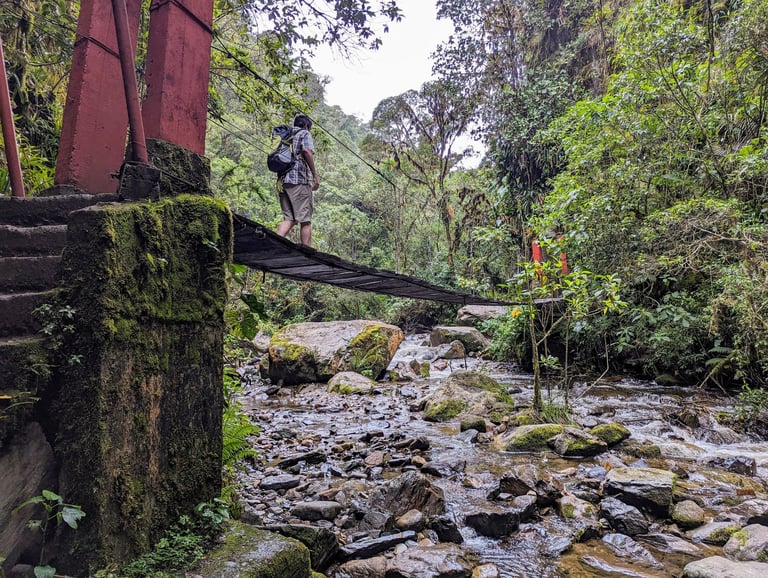
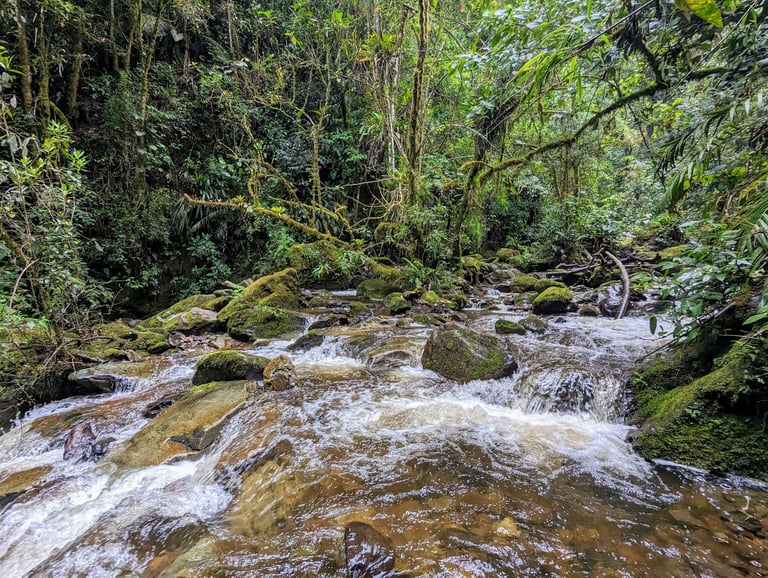
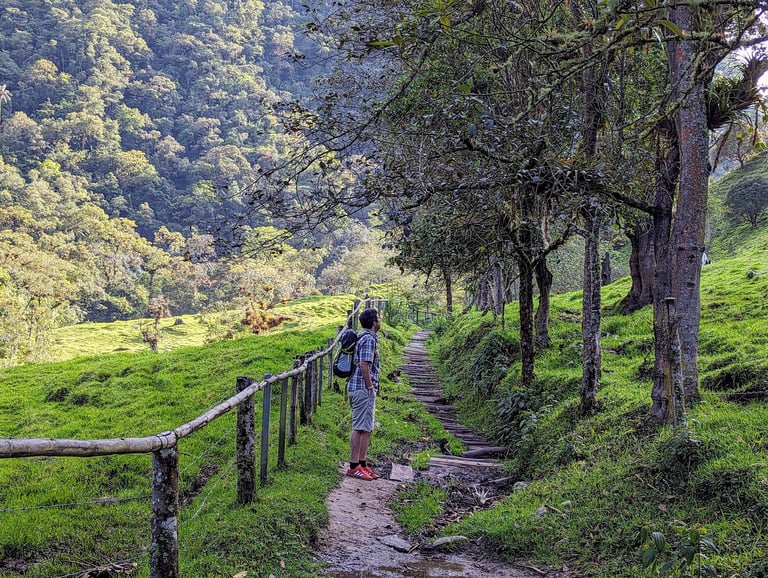
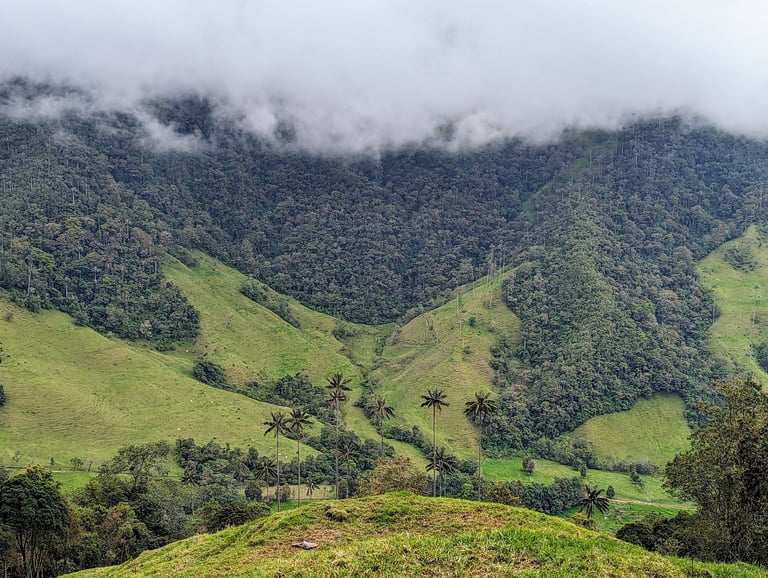
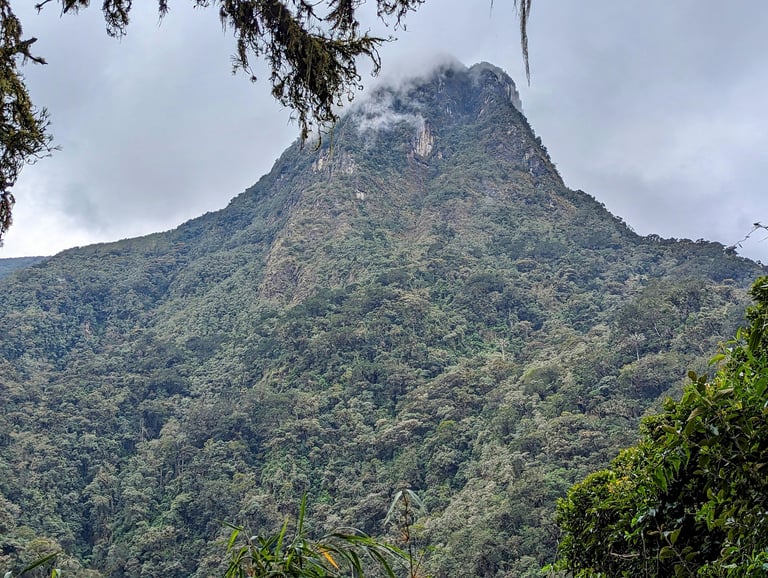
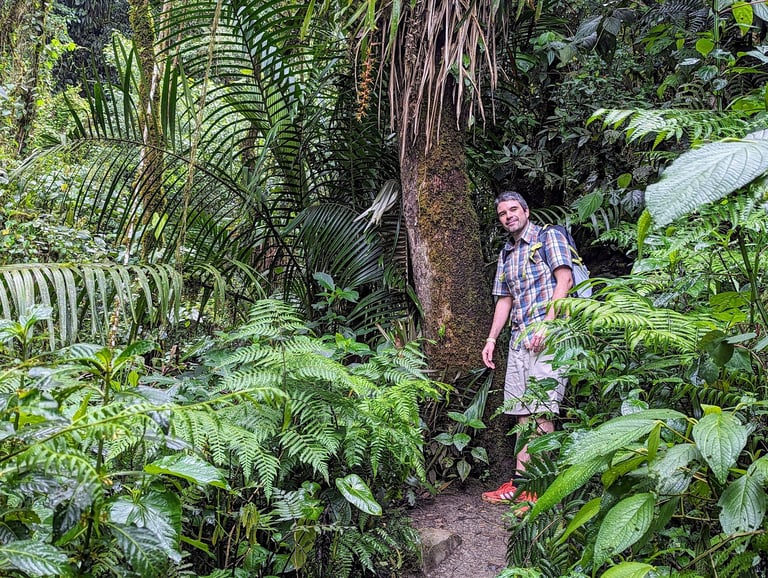
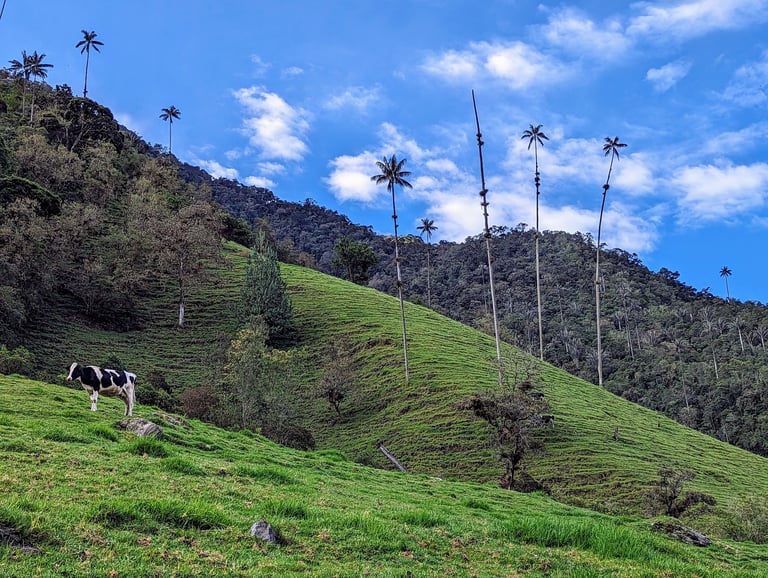
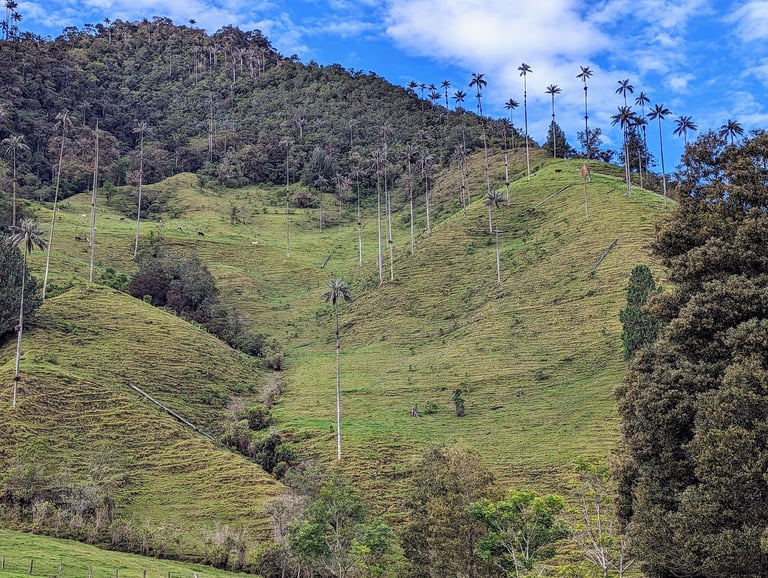










If you're not much of a trekker, you can still see the Cocora Valley by doing the clockwise walk but just going to the viewpoints and the same way back, instead of doing a loop. That's still a fair bit of a climb up (about 400m ascent), but it's just 4.5km or so return trip instead of 9.8km (if skipping the Humming Bird house). It will also only cost you $20,000 in entrace fees instead of $26,000 pesos for the loop (or $51,000 pesos if including Hummingbird House). If doing this, make sure you're taking one of the earliest Willys from Salento, as the place gets incredibly crowded as the day goes on.
The hike can easily be done on your own independently, especially with the help of the AllTrails app. However, if you don't feel comfortable doing the trek on your own, it is possible to go on a tour from Salento instead, or even combine a tour of the Cocora Valley with a coffee tour, which is very popular.
Medellin
Our next destination after Salento was the city of Medellín. Fortunately we had gone to the bus station the day before to get bus tickets to go to Medellín direct from Salento, as these were not being sold online and when we travelled the following day, there were people arriving disappointed that all the tickets for that day had sold out. So I definitely recommend buying your onward travel at least the day before.
After our bus experience from Pereira to Salento we were a bit worried about the 4hr journey from Salento to Medellín in the event it was the same sort of bus, which had no air conditioning, no view through the windows which had been sprayed black, no space for luggage anywhere or even space for people for that matter. That journey had quite possibly been the very worst bus journey we had ever been on but fortunately it hadn't been long. The trip to Medellín however was fairly long, and would be utter torture if we'd get the same kind of bus. However, the bus arrived and much to our relief the bus had proper seats, proper windows, proper air conditioning and even a toilet. Phew.
I personally recommend doing the bus journey to Medellín - the landscape is absolutely gorgeous on the way. Granted, it is very mountainous and there are some hair-raising hairpin turns, but it's worth it.
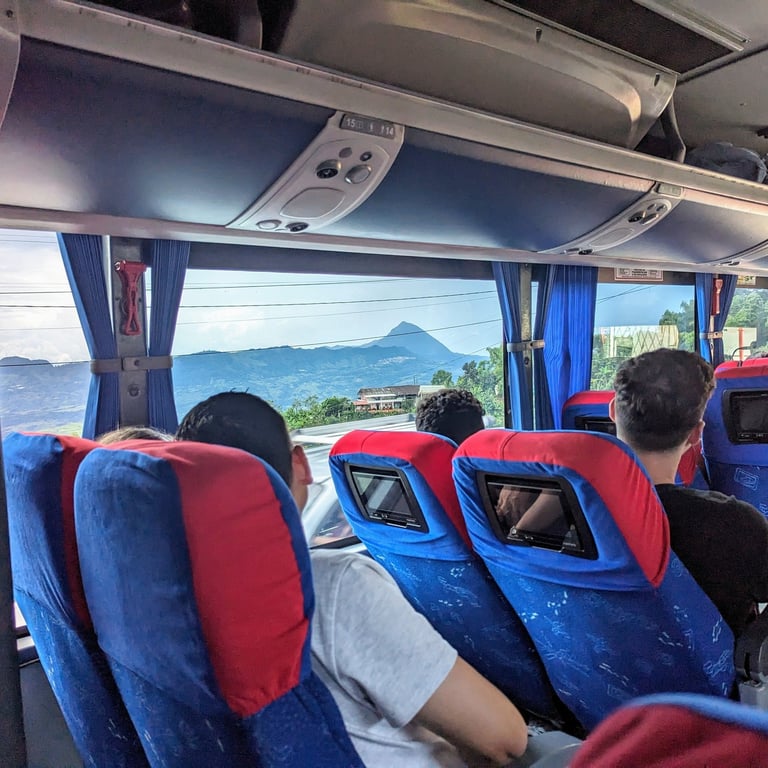
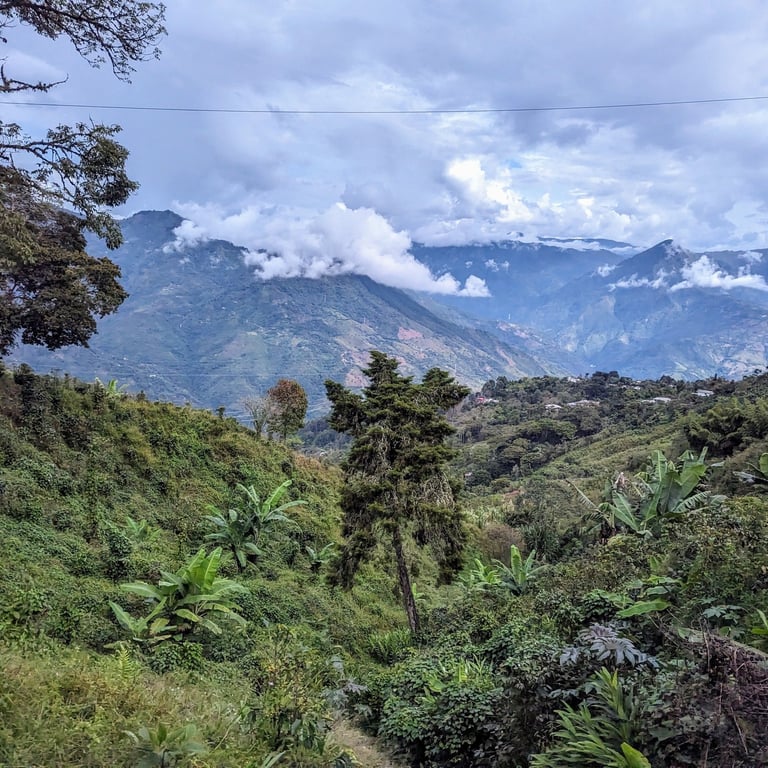
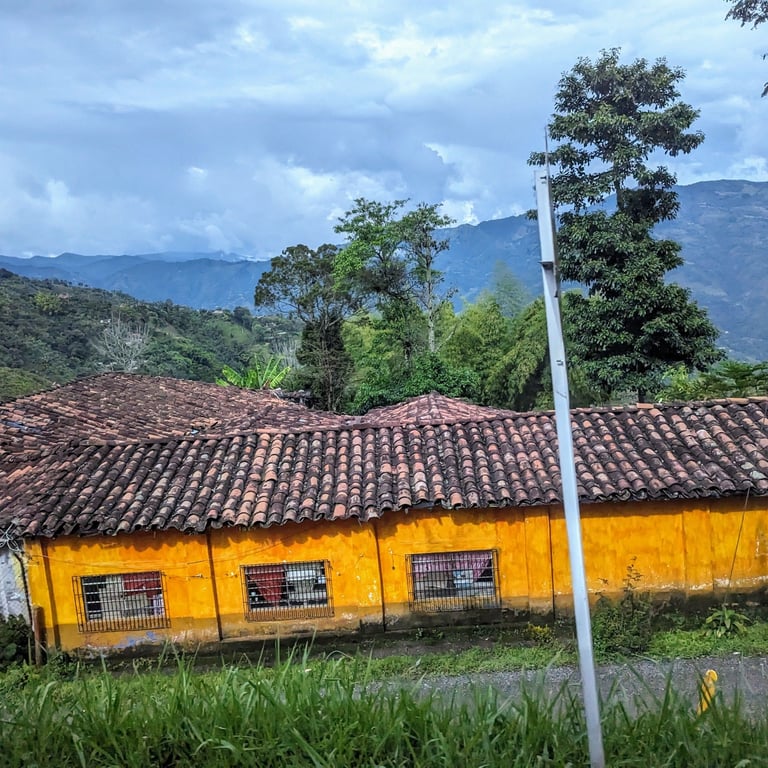
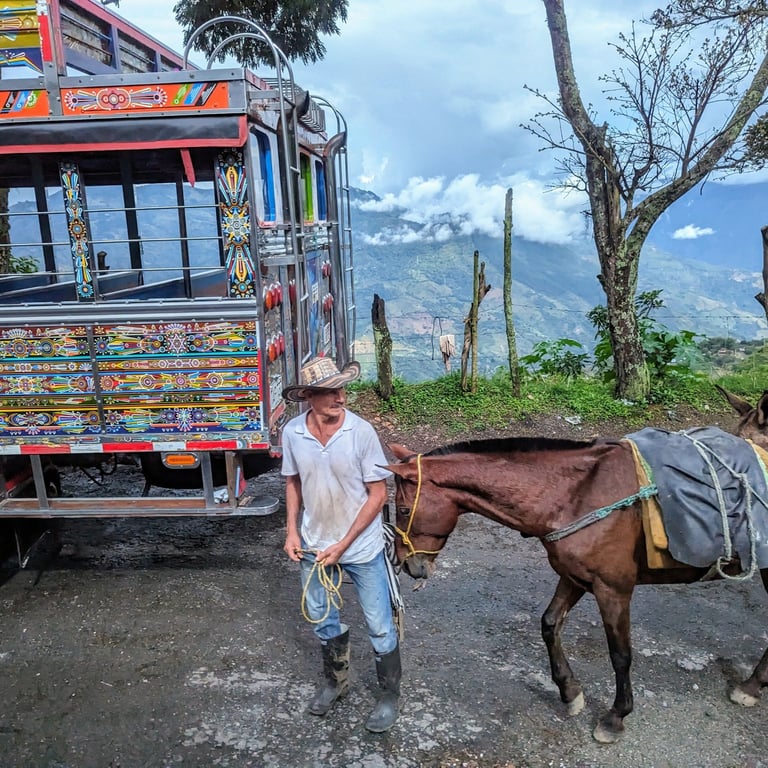
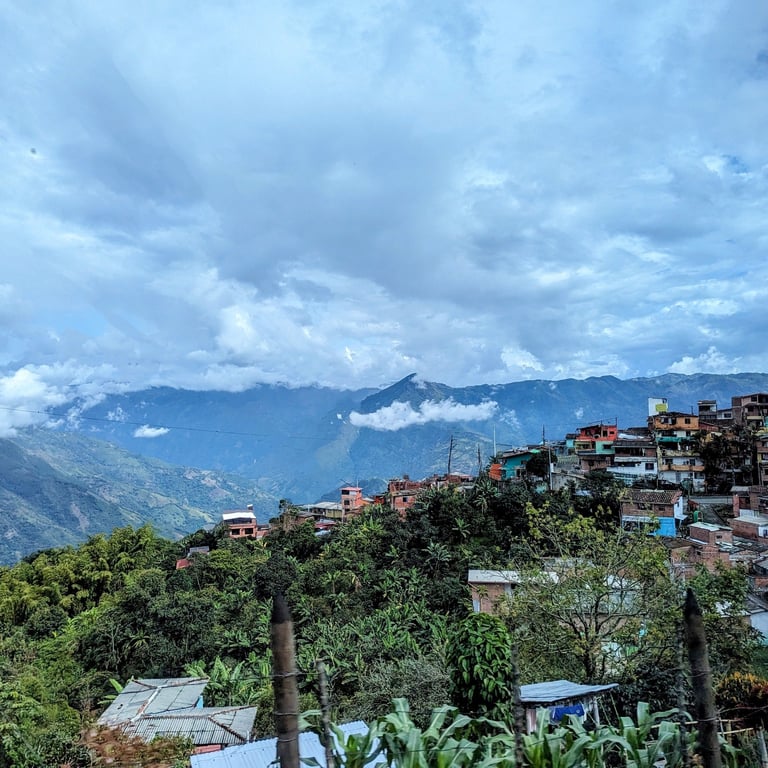
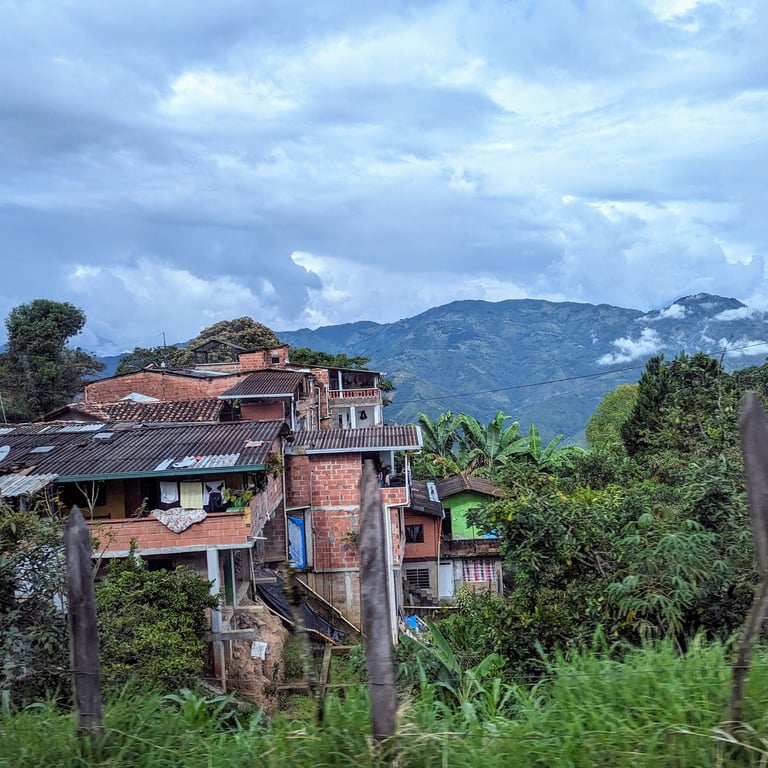
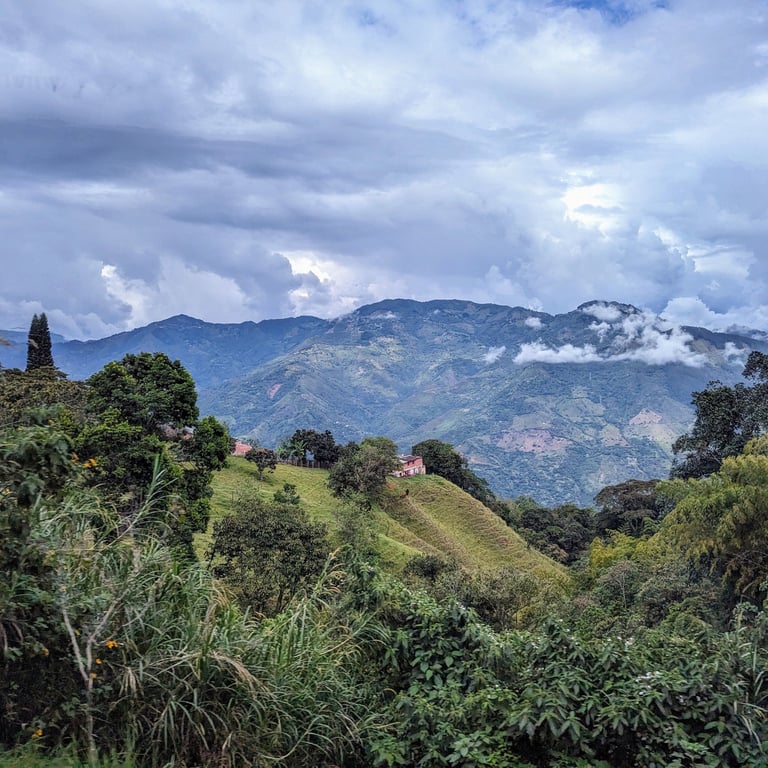
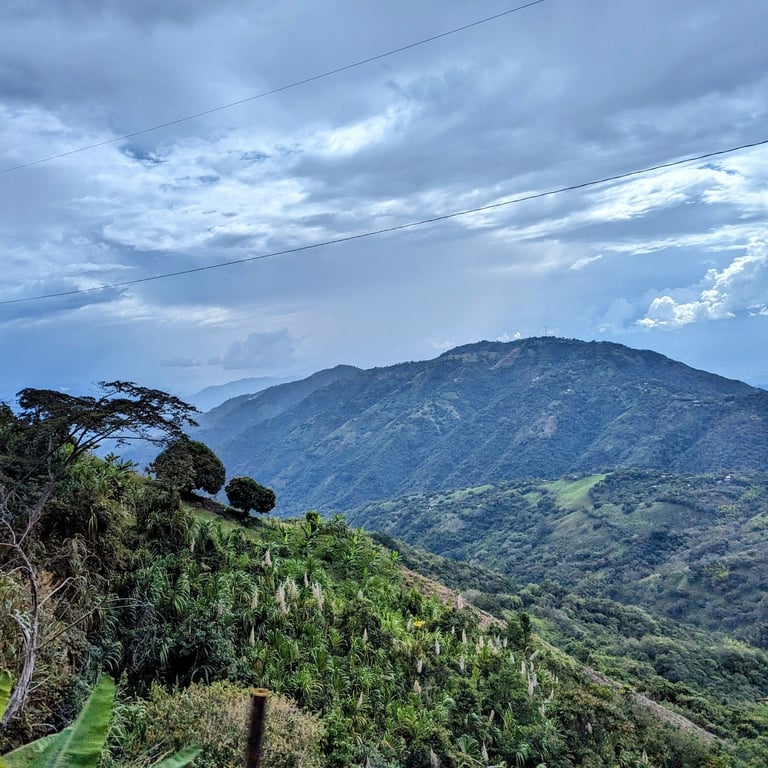
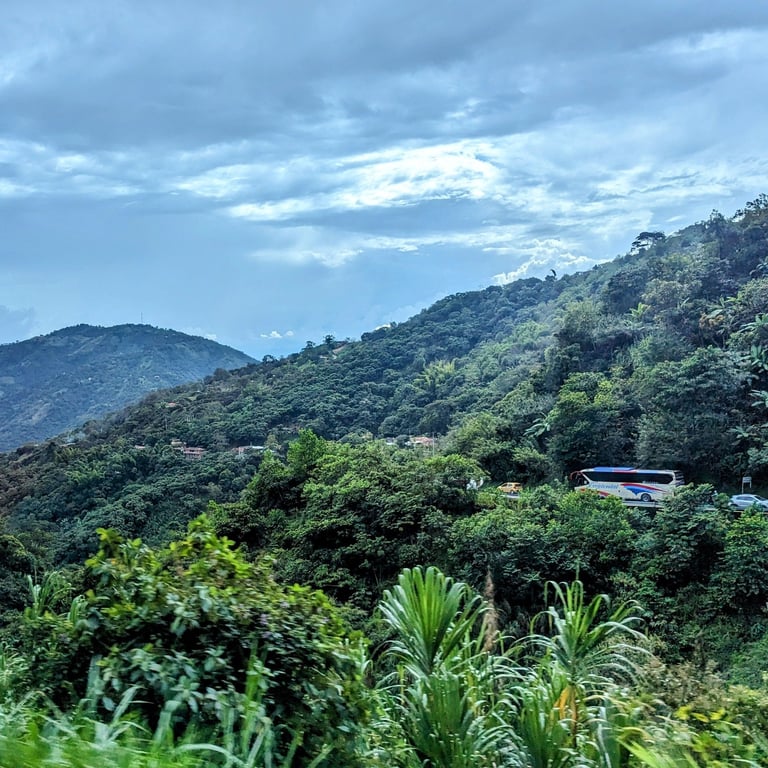
The beautiful countryside during our journey through Quindio, Risaralda and Antioquia on our way to Medellin
The bus was fairly punctual and we found ourselves a taxi to get to our accommodation in the Laureles neighbourhood. Rated the world's coolest neighbourhood in a comprehensive survey by TimeOut Magazine, Laureles is a vibrant neighborhood in Medellin, known for its relaxed atmosphere, tree-lined streets, and local charm. It's often described as a more community-oriented alternative to the bustling El Poblado, which is also a popular place to stay among travellers. Laureles is also a cultural hub, with attractions like the Teatro Metropolitano and the Universidad Pontificia Bolivariana. We rented ourselves a fantastic flat through AirBnB which I highly recommend. It cost us £69 per night, had all creature comforts and within walkable distance to shops and restaurants.
Medellín is well-connected through José María Córdova International Airport and an efficient public transportation system, however we ended up using taxis while we were there just cause they were really cheap. Also note that while you'll see there is an actual airport in Medellín city, don't make the same mistake as us assuming that this is the airport you'll be flying out of. We took the bus into Medellín so we didn't arrive at the airport. However, when we were due to leave to go to Cartagena, I just assumed that the local airport was the airport serving local flights and adjusted our time accordingly for flying. ERrrhh WRONG! Medellín Airport is actually literally located in the middle of the countryside, miles upon miles away from the city!
Medellín is often referred to as the "City of Eternal Spring" due to its pleasant climate, is a vibrant city with a unique blend of culture, innovation and natural beauty. The temperature typically ranges between 16°C and 28°C (61°F to 82°F), making it a pleasant destination in any season. However, what probably makes it the most famous is its history involving Pablo Escobar and the Medellin cartel, made ever more famous through the excellent (and highly recommended!) Netflix series "Narcos". If you're planning a trip to Colombia and haven't seen the series, see it! It gives you a lot of historical context. Medellín's transformation story following the downfall of Pablo Escobar and the MedellínCartel, combined with its cultural richness, makes it a symbol of resilience and creativity, attracting tourists, entrepreneurs, and expats from around the world.
The city is popular among expats and travellers alike, many people ending up staying in Medellín for extended periods of time. The main attractions include:
Plaza Botero: You will be told by any local that you must visit this place. This square features sculptures by Fernando Botero, a famous Colombian artist known for his "voluminous" style. It's an iconic spot in Medellín. Museo de Antioquia: Adjacent to Plaza Botero, this museum houses an extensive collection of Botero’s works and showcases local history and culture. We did not make it there as we were in Medellín too short of a time and we were hindered in some of our travels by rain that was reluctant to stop. We did however visit the Botero Museum in Bogota.
Street Art: Medellín's walls are alive with vibrant murals, particularly in neighborhoods like Comuna 13, showcasing stories of resilience and hope.
Arví Ecotourism Park: A large nature reserve easily accessible via a cable car ride. Visitors can hike, bike, or enjoy eco-tours in the serene Andean forest. Cerro Nutibara: This hill offers panoramic views of the city and is home to the Pueblito Paisa, a replica of a traditional Antioquian village.
Gastronomy: Medellín's food scene is thriving, with a mix of traditional and modern culinary offerings. Signature dishes include bandeja paisa (a hearty platter with beans, rice, plantain, meat, and avocado) and arepas (corn cakes). The city also has a burgeoning coffee culture, with specialty coffee shops showcasing Colombia's world-renowned beans. Though we didn't have the best of luck with our choice of places to eat. If you know of good places, get us on our socials and we might include it!
Nightlife: The nightlife in Medellín is lively, especially in areas like El Poblado and Laureles, where visitors can enjoy bars, clubs, and live music.
While we were in Medellín, we went to a few places for food and drink even though we had a flat where we could cook.
Pimiento's Gourmet Pizza, Laureles: The pizzas were just allright but were just what we needed. Joe liked their pizzas more than me. We paid around £10 GBP total for two medium pizzas ($60,000 pesos).
Sazon d'panas Venezuelan Restaurant, Laureles: Criollo style breakfast came to $24,500 pesos per person with coffee (so about £4.45 each). The breakfast was fantastic, but we later had some Arepas from them for dinner, expecting the same quality of food but was pretty disappointing.
Barbaro Restaurant, Laureles: This restaurant looked really promising, the atmosphere was great and the price point suggested we'd be in for a treat at this BBQ restaurant where the meats are cooked on live fire. They charge $230,000 pesos for each ribeye (£41.40), which is what we ordered, only to be sorely disappointed and left feeling ripped off. Don't recommend.
Torrealta Microbrewery bar in Laureles: The bar is very modern and serves their own microbrewery beer, which cost us $14,815 per craftbeer (about £2.70 GBP) and $26,850 pesos (about £4.80 GBP) for a flight of 5 different beers. We would have gone back if we had had more time in Medellin. Nice place.
Medellin Beer Factory in El Poblado: We had bigger hopes for this place, assuming it would be something similar to the Torrealta or craftbeer places in general. However, it felt very run-down and there were no customers around. We ordered for nachos for $38,900 pesos (£7), chips with refried beans & cheese $32,900 pesos (£5.80), 6 chicken wings & potatoes for $29,800 pesos (£5.30) and 2 big beers $20,000 each (£3.60 GBP). Everything tasted great, alveit a bit on the pricy side for Colombia (maybe the reason why nobody was there?). While the place was "fine" I wouldn't specifically recommend it.
Barrica Brewery Pub in El Poblado: A great wee place that serves proper craftbeer, much to our delight! The drinks were at about $18,000 pesos (£3.20 GBP) per small beer with alcohol volumes typically ranging 6-9%. The place would get top top marks if the waiting staff hadn't been so terribly uninterested, but I still recommend this place for sure if you love your craft beer like we do.
Comuna 13 of Medellin
We weren't really lucky with the weather while we were in Medellín, so we only really managed to do one of the tours we wanted to do, which is a MUST DO tour when in Medellín, if not whole of Colombia. That is the walking tour of Comuna 13, which I absolutely did not want to miss, even if it rained on us.
Probably the most popular area of all of Medellín, Comuna 13 is famous for its transformation, from a dangerous, violence-ridden area during the brutally violent reign of Pablo Escobar and the Medellín Cartel, into a vibrant, culturally rich neighborhood. Once the most dangerous neighborhood in Medellín, it has a tumultuous history marked by violence and displacement. It was a stronghold of drug cartels, paramilitary groups, and guerrillas, leading to a high homicide rate and fear among residents.
In the 2000s, the community experienced a significant transformation, driven by government initiatives and community efforts, and is now known for its vibrant street art and cultural scene. The community can serve as a role model for other city councils which struggle with violence, but Comuna 13 stands as a powerful example of how a community can overcome adversity. Despite its turbulent past, the neighborhood has reinvented itself, fostering pride and a sense of unity among its residents. Its remarkable journey of change has turned it into a symbol of resilience and community empowerment. The government and local communities began efforts to address the violence and improve the living conditions in Comuna 13. Investments in public infrastructure improved accessibility for the local population, especially the outdoor escalators installed to help residents navigate the steep hills of the neighborhood. These escalators have made it easier for people to access the upper parts of the community as well as accessing places of work / education and have become an important symbol of the neighborhood's progress. Investments in education, social programs and community-driven initiatives also played a crucial role in turning the area around. The residents of Comuna 13 have organized numerous social projects, such as dance schools, educational programs, and cultural activities, to offer youth alternatives to gang involvement. It has also become internationally renowned for its vibrant street art and murals, but local artists have used the walls of the neighborhood to express messages of hope, resistance, and change, turning the area into an open-air gallery. The art tells the story of the community's struggles and resilience and is a major draw for tourists.
Today, Comuna 13 is a vibrant cultural hotspot. The neighborhood is home to art, music, dance (particularly breakdancing and hip-hop), and street performances. It attracts tourists from around the world who come to experience its art, history, and community spirit. Local guides often lead tours, providing insights into the neighborhood's past and present, but we booked ourself into one of those walking tours that takes you around the neighbourhood, with some clips from the tour in the video below.

Cartagena de Indias
Our next stop after Medellín was the ancient city of Cartagena where we were going to spend New Years Eve with Loreidis, the girl I sponsored through Children International from the year 2004 until she graduated from the programme in 2017. I had already met her once before back in 2007 when she was 9 years old. Now she had become a grown-up and with two children, a 9 year old boy and a 1 year old baby boy. Another reason to go to Cartagena was also to see a boy from Barranquilla I've sponsored since 2010 and in the 14 years I had been his madrina, I had never travelled to Colombia to meet him, so now was finally the time.
First, we met Loreidis in Cartagena, but I had invited her and her family over to celebrate New Years Eve together. It was wonderful to meet her very nice partner, as well as her two boys I had never met before. While there, we stayed at a hotel called OZ Luxury Hotel in Bocagrande (don't be fooled by the name, it's not luxurious but it is very good indeed for the price you pay!) while Loreidis and her family stayed in a small Airbnb flat that I sorted them out with.
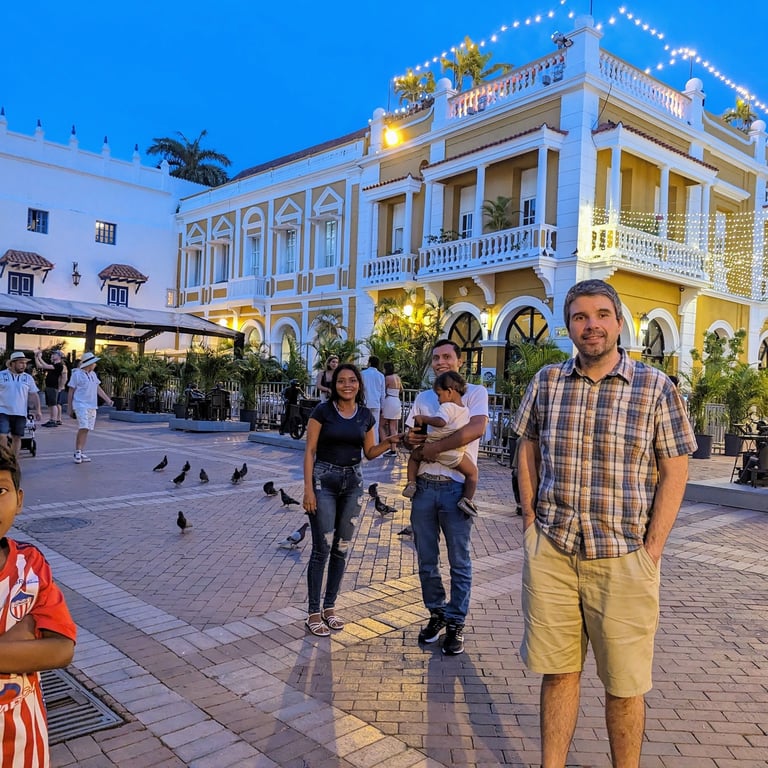
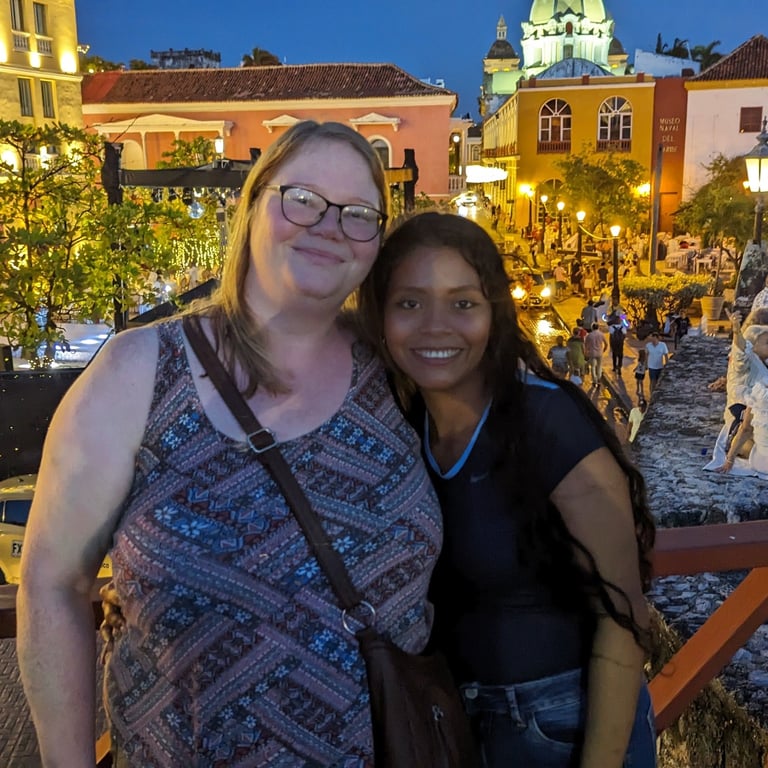
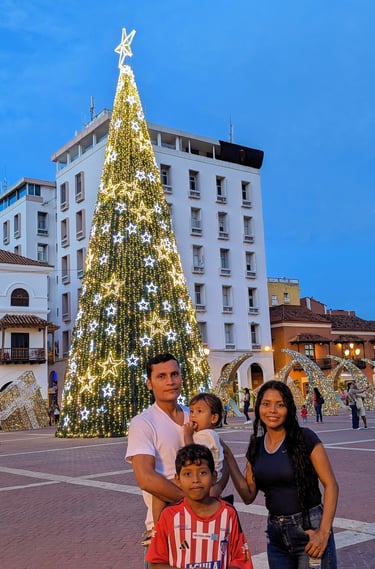

Finally meeting Loreidis again after not seeing each other for 17 years
Loreidis had never been to the old city centre of Cartagena and it was wonderful to see how amazed and fascinated she was of the city that is so close to where she's from, but has never been. Cartagena de Indias is the undisputed queen of the Caribbean coast surrounded by beautiful beaches and islands. It is a historic city contains well-preserved colonial architecture which includes colorful buildings, grand churches and impressive plazas. In fact, it is one of the most important historical cities in the Americas, having played a crucial role during the Spanish colonial era. It was a major port for gold, silver, and other treasures from the Americas and served as a strategic military base. It was also the first city in modern-day Colombia to declare independence from Spain in 1811.
The old walled city is a UNESCO World Heritage site and includes the 17th-century fortress of San Felipe de Barajas, built to protect it from pirate attacks and remain iconic features of the city today. The old city lies on a peninsula and the island of Getsemaní, but the city now spreads over the islands of Manga and Manzanillo and the mainland below La Popa Hill. In the old section are the ornate cathedral, the Church of San Pedro Claver (1603), the Palace of the Inquisition (1706), the main plaza, and the University of Cartagena (1827). The city faces the Caribbean to the west; to the south its bay has two entrances: Boca Chica (Little Mouth) and Boca Grande (Big Mouth). Boca Chica historically was the deep water entrance and was so narrow it allowed the passage of only one ship at a time. This entrance was defended on one side by the Fort San Luis with a couple of small outworks on the peninsula of Tierra Bomba, and on the other side by the fascine battery Baradera. Beyond Boca Chica was the lagoon of the outer harbour with an entry channel into the inner harbour between two peninsulas, each defended by a fort. The walls of the city itself mounted some 160 cannon, while the suburbs had 140 guns. The city was surrounded by a moat and its gates were guarded by recently built bastions. The suburbs were also surrounded by a moat. On a hill about a quarter mile south of the city stood Fort San Lazaro, a square fifty feet on a side with three demi-bastions. The fort's position commanded the city itself and the plain around the hill. Another small hill nearby defended the fort, but there was no fresh water source available outside Cartagena and the fort. The road from the best landing point, the beach at Texar de Gracias, ran three miles to Fort Lazaro.
Founded in 1533, Cartagena de Indias gained fame after the mid-16th century when great fleets stopped annually to take on gold and other products of northern South America for convoy to Spain. The city became a centre for the Inquisition and a major slave market. Founded by Pedro de Heredia in 1533, Cartagena de Indias of the 18th century was a large and rich city of over 10,000 people. It was the capital of the province of Cartagena and had significant fortifications that had been recently repaired, enlarged and improved with outlying forts, batteries and works. Its harbour, considered by some observers to be one of the finest in the world, served the galleons of the commercial fleet (Galeones a Tierra Firme y Perú) that annually assembled at Havana to convoy the immense revenues of gold and silver from New Granada and Peru to Spain.
In the 20th century it experienced renewed growth and is now Colombia’s fifth largest city. Probably the most significant factor in Cartagena’s revitalization was the opening of petroleum fields in the Magdalena River valley after 1917. The completion of the pipeline from Barrancabermeja to the Bahía de Cartagena in 1926, and the building of an oil refinery, helped make the city the country’s chief oil port; platinum and coffee are other important exports. The old city is very popular with tourists due to its charm and beauty with its cobblestone streets, colorful buildings, and tropical climate.
The historic centre is quite small and you can easily see every inch of it within 2 days, so unless you plan to go on tours you don't need longer than that here. There are however a few daytrips you can do that I think are worthwhile. We didn't do it this time as we had company but also because I had been to these places before some 17 years earlier. One of these places is the Islas del Rosario islands just off the coast of Cartagena. Colombia's mainland doesn't have very many good or attractive beaches or reefs, with perhaps the exception of the Tayrona National Park and surrounding area near Santa Marta. The other one being Islas del Rosario, with sea so inviting it is impossible to resist jumping in. The islands are known for their coral reefs and crystal-clear waters, making them a popular destination for snorkelling and diving. The below photos were taken by me on my trip back in 2007, so much may have changed since then.
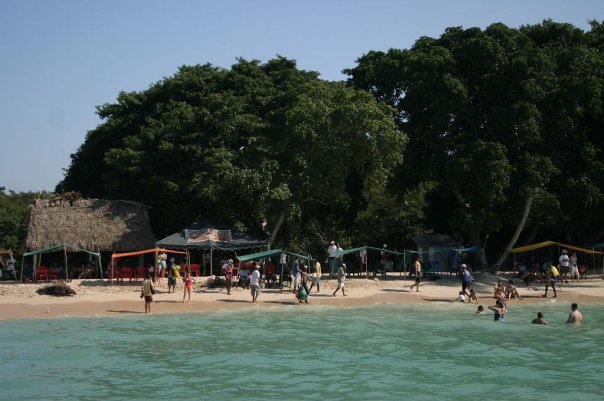
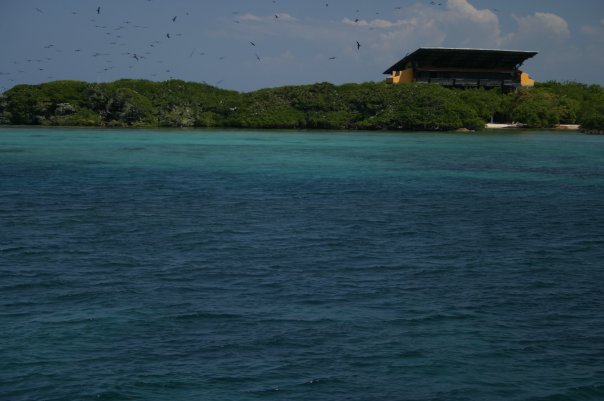
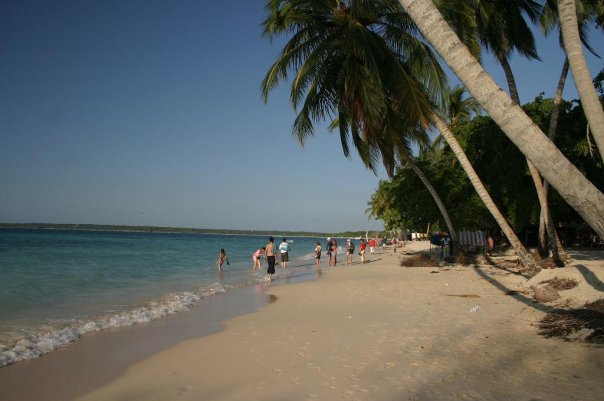
Islas del Rosario daytrip from Cartagena
The other place I visited when I was in Cartagena back in 2007 was the Totumo Mud Volcano, which was a really odd experience but also great fun. The Totumo Mud Volcano (Spanish: Volcán de Lodo El Totumo) is located about an hour from Cartagena, but unlike typical volcanoes that spew molten rock, Totumo expels warm, thick mineral-rich mud. The mud volcano is around 15m high and there's a man-made staircase leading to the top, where people can go into the crater and bathe in the mud.The mud is buoyant, meaning you float effortlessly—even if you try to sink, you won’t! The mud is believed to be rich in minerals like magnesium and calcium. Locals claim it has healing and skin-purifying benefits, attracting both tourists and those seeking natural remedies.
After the mud bath, visitors are escorted to a nearby lagoon or river where local women offer to wash off the mud—for a tip. It’s a rustic but entertaining part of the experience. It's recommended to wear an old swimsuit, as the mud can stain. It's also important to bring cash for tips (for the mud "massage," photo holding, and post-bath washing). There are no changing rooms —just basic facilities. The experience is quirky and fun, but not luxurious—be ready for a bit of chaos and charm.
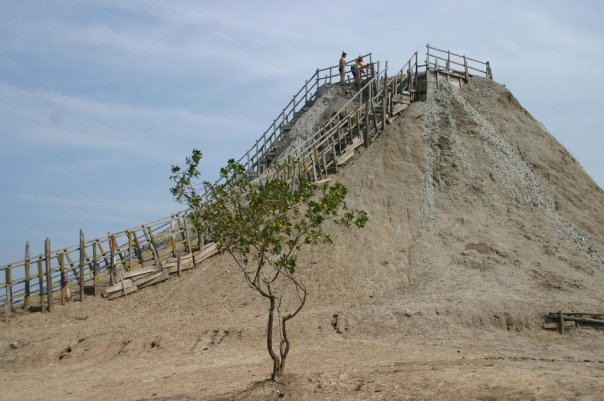
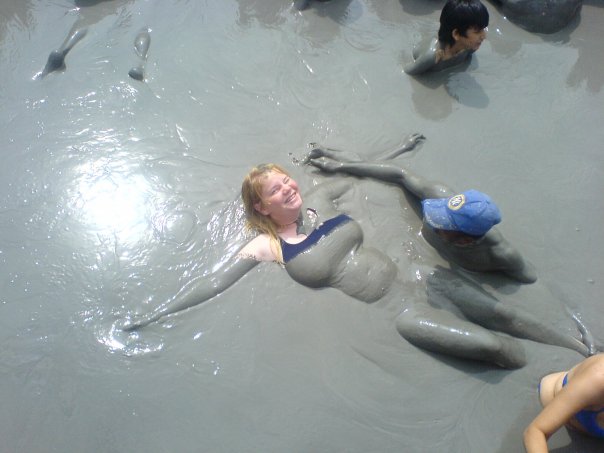
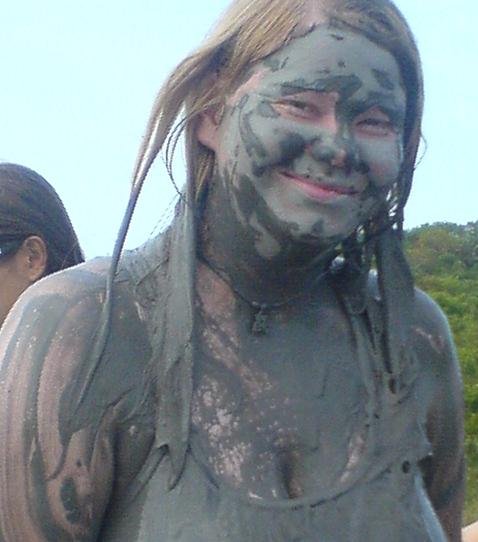
My visit to the Totumo Mud Volcano near Cartagena de Indias back in 2007
While we were in Cartagena in January 2025, we enjoyed walking around the city, which is a pleasure. The buildings in the old city genuinely are just so beautiful and colourful, you feel like you're on some sort of a film set. There is also a park in the old town called Parque Centenario where we had learned that there's a fair few animals that live quite happily and wild in the park and they've grown up around humans, who don't harm them, so they are not the slightest bit scared of people. We weren't too hopeful we'd see much due to the fact that there had been crazy fireworks, loud music and parties going on the night before (New Years Eve). The first time we walked through the park, we saw absolutely nothing, but the second time we walked through it, we saw sloths, monkeys and iguanas! I was clearly over the moon to get to see all these animals. Below are a few clips from Cartagena and Parque Centenario that I took when we were there.

During our short time in Cartagena we went out to eat a few times. Below is a summary of where we went, prices and whether we recommend the places or not.
The Clock Pub in the Walled City: However, we discovered this pub at the entrance to the walled city and that pub basically became our second home while we were in the city. They had great snacks like loaded nachos and such things, fantastic burgers and tasty craft beer in a super cosy pub with very attentive friendly staff. What more can one ask for! One of our favourite wee places in Colombia. It's a bit on the more expensive side, but we thought it was worth it for the quality.
Cartagena Nami Restaurante in Bocagrande: We struggled to find somewhere to eat in Bocagrande as most places were a total ripoff or didn't have anything we fancied or were completely full of people but we managed to get a seat at Nami, which served tasty (but not phenomenal) Asian food. We had the orange chicken w/rice for $42,000 pesos (£7.50 GBP), the Katsu pork for $45,000 pesos (£8 GBP), and some small Club Colombia beers which cost $10,000 pesos (£1.80 GBP) each. Overall, do recommend. Also, the staff were very nice. A couple had forgotten a bag and the waitress was super swift in picking it up, shouting after the couple as they walked away and gave them their stuff back. Honest folk. Very nice.
KFC Bocagrande: One of those times when we tried to find somewhere to eat in Bocagrande and found ourselves in KFC for an "easy known choice". I was completely shocked at how insanely inefficient the service was.... I kid you not, it took like 1.5hrs or similar to get served a couple of Zinger Tower burgers with chips... how mad is that. Definitely don't recommend.
Pirka Peruano in Bocagrande: We took Loreidis and her family to this Peruvian restaurant for New Years Eve dinner, as I wanted to introduce them to this incredible cuisine (I'm a huge fan of Peruvian food). Unfortunately, I was a bit disappointed with the authenticty of the food... I can make these dishes better and more authentic myself, which makes me a bit sad when I'm trying to treat myself and others. We went for the Causa Limeña which cost $28,000 pesos (£5 GBP), Lomo Saltado $55,000 pesos (£9.80 GBP), Arroz de mariscos (stir-fried rice with shellfish) for $60,000 pesos (£10.70), Salmon for $70,000 (£12.50 GBP), 4x Cusqueña beers for a total of $56,000 (£10 GBP) and 3x natural juices for a total of $46,000 pesos (£8.20 GBP). Don't get me wrong, it wasn't bad, in fact it was probably some of the better food we had in Colombia, but it isn't particularly authentic Peruvian flavours.
Boca-Rica Restaurant in Bocagrande: We went here as soon as we found Loreidis and her family in Bocagrande in Cartagena, as all of our tummies were rumbling. Even though the restaurant was picked on a total whim, as we just went to pretty much the first place we saw, it turned out to be a fantastic choice. It has typical Colombian food and Loreidis recommended me a fish called "Mojarra", which she said is a river-based fish that is common where she lives near the river in Soledad near Barranquilla. She and her entire family ordered the Mojarra and as did I, and boy it did not disappoint. The fish was cooked to perfection and just how I like it, with the skin and bones still intact, allowing for maximum flavour. Joe didn't feel as adventurous and went for the salchipapas, a mix of sausages, chips and other incredients, which I think he liked. The Mojarra cost $42,000 pesos (£7.50 GBP) each, Salchipapas $22,000 pesos (£3.90 GBP), Club colombia beers cost $10,000 pesos (£1.80 GBP) each and Coca cola $7000 pesos (£1.25 GBP) each. The only downside was that the service was terribly slow (and probably felt even slower due to our tummies rumbling) but the food was great. Recommend.
Juan Valdez in Bocagrande: Colombia is famous for coffee and people who know Colombian coffee love the Juan Valdez coffee. They have coffee houses everywhere, they're like the Starbucks of Colombia. We just had Frappuchino type of coffees there, as we wanted a bit of a cold "pick me up" in the heat, but 2 such frappuchinos cost a total of $33,400 pesos (£5.95).
Drinks shack at Playa Hollywood beach in Bocagrande: We were ready to get completely ripped off here, as the internet is flooded with tales of people saying that they've been scammed or ripped off at the Bocagrande beaches. However, we sat down and had a very reasonably priced Club Colombia beer here in the sun, for just $8,000 pesos (£1.45 GBP), cheaper than most places we had been to date.
La Paletteria: An ice cream shop in the old town that we managed to catch just in time before they closed for the New Years celebrations. Me and Joe loved our ice creams but Loreidis had gone for the lemon one that was crazy acidy. The ice cream there is pretty pricy even for European standards, at £5 GBP a pop!
For those of you who prefer pictures, below are some (many!) photos I took during the days around the New Years Eve 2024/2025 we spent in Cartagena. The city is just so incredibly Instagrammable, you just want to take pictures on every corner.
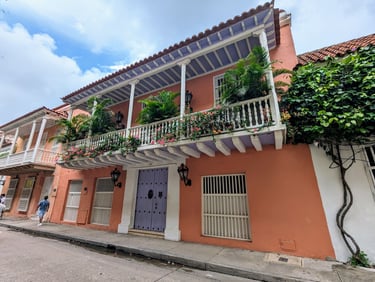
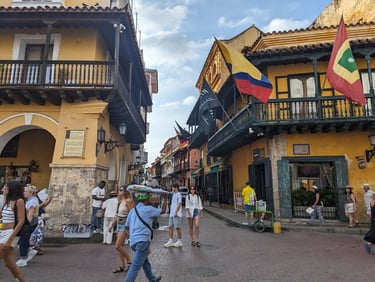
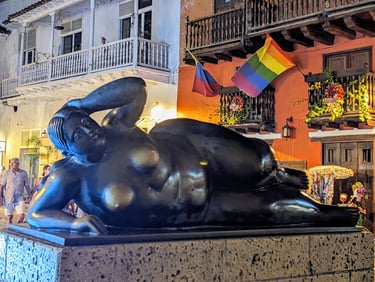
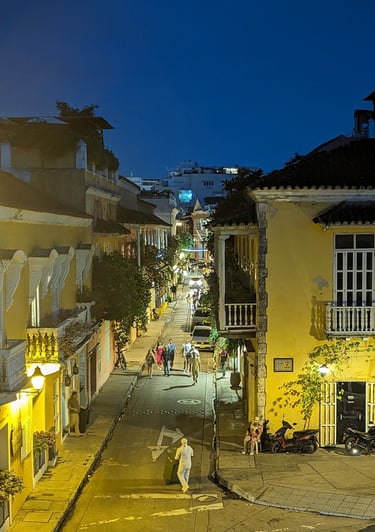
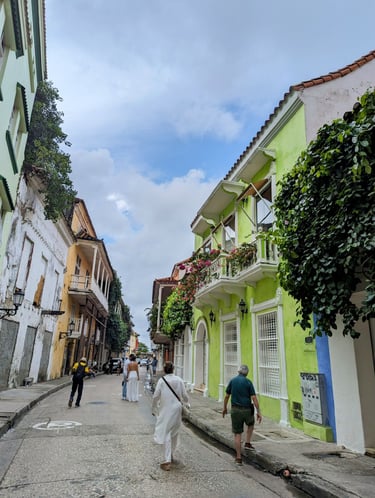
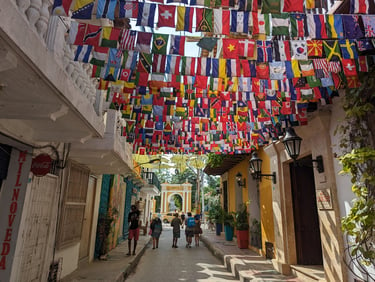
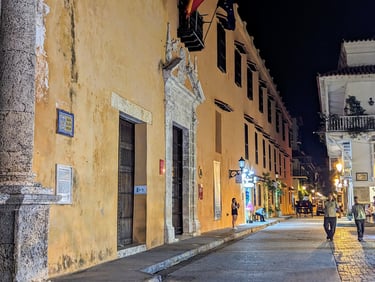
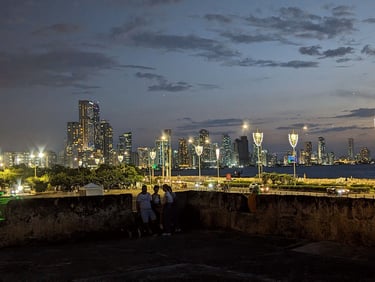
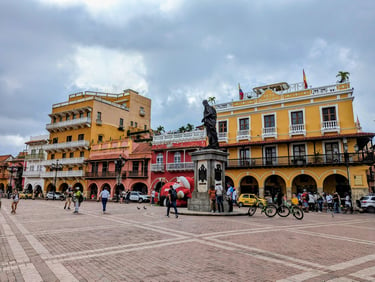
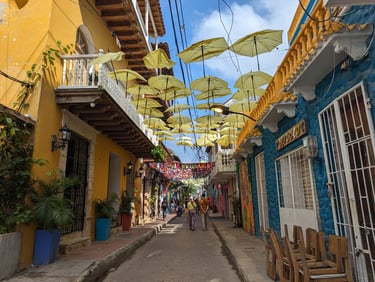
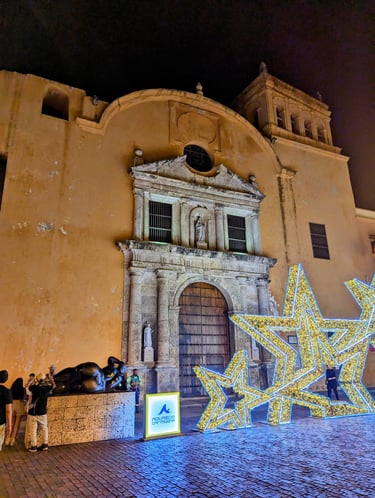
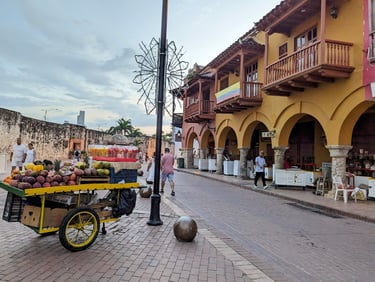
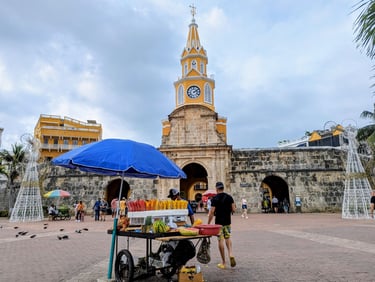
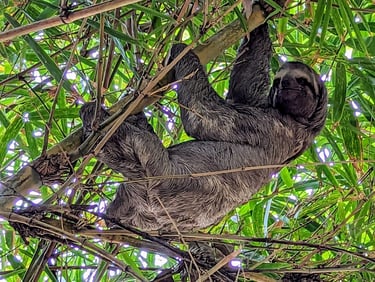
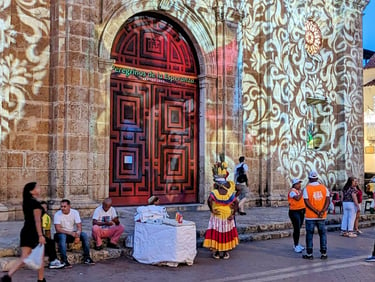
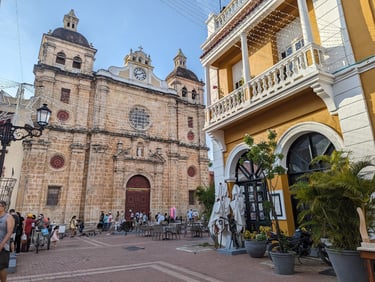
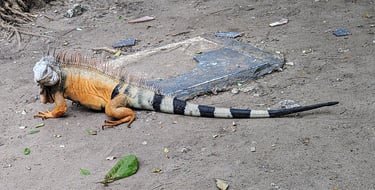
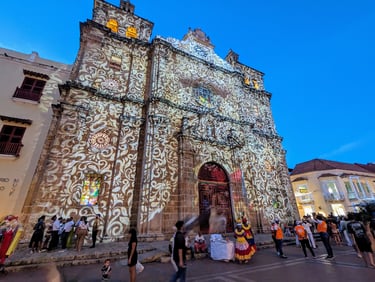
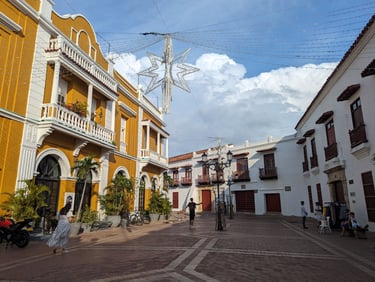
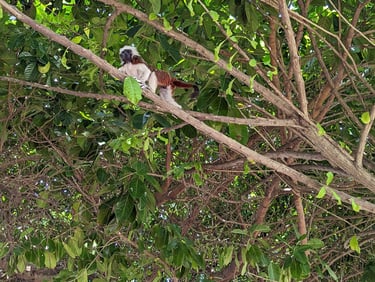
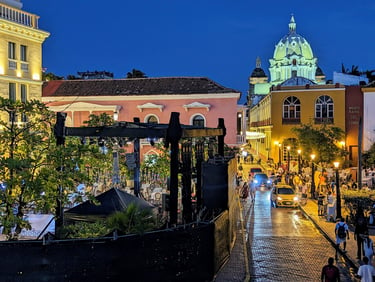





















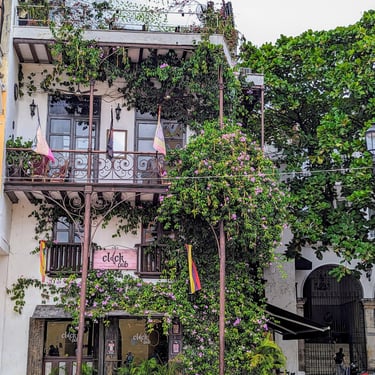
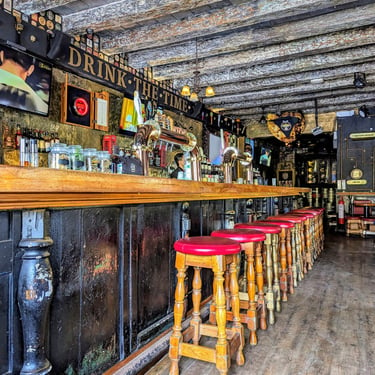
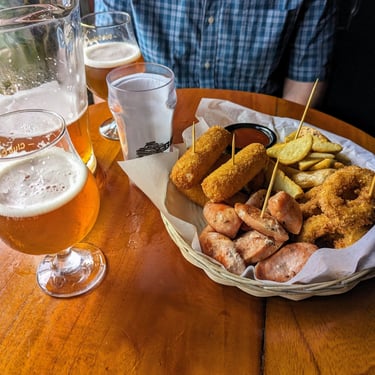
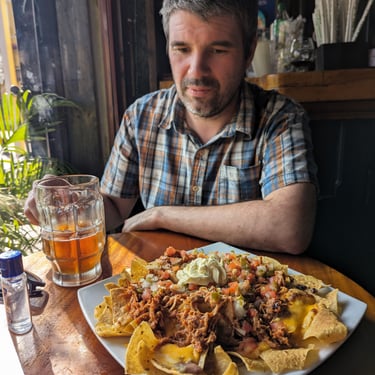
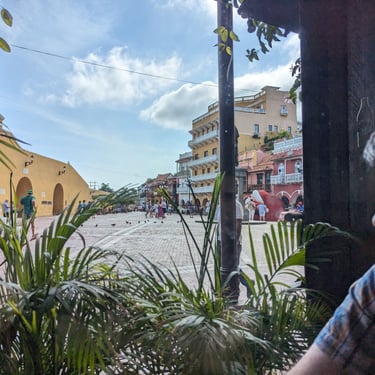
Our favourite hangout place in Cartagena - The CLock Pub in the Walled City
Barranquilla
I have been to Barranquilla once before, when I went to visit Loreidis, the girl I was sponsoring at the time, back in 2007. I started sponsoring another child, Emanuel, back in 2010 when he was just 2 years old. He was now turning 17 years old and not far from graduating from the Children International programme, which prompted the trip to Colombia as I had never had the opportunity to meet him, despite him writing me regularly asking when I would come to see him. The staff at the local office of Children International in Barranquilla, where most of the CI programmes in Colombia are based, were kind enough to take time out of their holidays to let me visit him in Barranquilla.
We were actually staying in Cartagena some 2.5 hrs away from the Children International office in Barranquilla where we had to arrive early in the morning, so it was a very early start for us and the way to go was to take a door to door taxi to Barranquilla. The Uber driver that drove us there was kind enough to offer to take us back at a discounted price, but he was just going to go visit a friend in Barranquilla while he waited for us. That was a long wait, as we were going to spend the whole day with Emanuel, his grandma and the CI social workers. Then we were going to see Loreidis again for dinner, as well as Loreidis' mum and her partner's mum too, along with the kids.
The reason why Children International operate in this city is due to the extreme poverty and the children need support. Fortunately, the government of Colombia has made some incredible changes to the social security system, which gives children in extreme poverty much more level of a playing field compared to what it used to be like when Loreidis was little, though there's still a way to go. But there is a bit more hope for children to be able to break out of the cycle of poverty if they play their cards right.
In Colombia, there's such a thing called "Estratos socioeconómicos" or socioeconomic strata, which is a social class system is primarily based on income, education, occupation, and lifestyle rather than race or ethnicity. However, historical inequalities have left lingering effects. The classes are often categorized into six “stratas” (estratos), which are used for public policy and utility billing. The estratos system divides neighborhoods into six categories based on socioeconomic characteristics, and typically the children that are accepted into the Children International programmes fall into Stratum 1 or 2. This system was created to subsidize utilities for lower-income households.
Stratum 1 (Low-Low):
Represents the poorest segment of society.
Residents often live in informal settlements or rural areas with limited access to infrastructure and services.
Receive the highest subsidies for utilities and other public services.
Primarily includes manual laborers, informal workers, and subsistence farmers.
Stratum 2 (Low):
Slightly better living conditions than Stratum 1.
Includes lower-income families living in modest housing in rural areas or urban outskirts.
Still heavily dependent on government subsidies for utilities and public services.
Stratum 3 (Lower Middle):
Represents working-class families with stable jobs, often in service or technical sectors.
Lives in modest homes or apartments in developing urban areas.
Receives limited subsidies but pays less for utilities compared to higher strata.
Stratum 4 (Middle):
Middle-class professionals and business owners.
Reside in comfortable neighborhoods with access to quality infrastructure and public services.
Pays for utilities without subsidies.
Stratum 5 (Upper Middle):
Wealthier professionals and executives.
Live in affluent areas with high-end housing and amenities.
Pay higher rates for utilities and public services.
Stratum 6 (High):
Represents Colombia’s wealthy elite.
Residents live in luxurious neighborhoods with upscale homes and access to exclusive services.
Pays the highest rates for utilities and often has significant political or economic influence.
Colombia has one of the highest levels of income inequality in Latin America, as measured by the Gini coefficient. Wealth is concentrated among the elite, while many Colombians live in poverty. Where someone lives can also signal their social class, as neighborhoods are often segregated by stratum. While the support from the government helps the poorest people a lot, it can be challenging to move up due to the income inequality, as there's a tendency to pay people who live in lower Stratum areas much less than elsewhere, so these people either have to travel very far for better jobs, which in itself is costly, or move to another area, which will in most cases be way beyond these people's means. This is certainly the issue that has been challenging for Loreidis, but even though I sponsored her through an Assistant Nursting degree, she struggles to find a job in her neighbourhood at all, or find any job anywhere that she can afford to commute to or able to commute to due to her child-caring responsibilities and the excessively long days away she'd have to do if including commuting.
I so sincerely hope that Emanuel gets better opportunities, but I continuously give him life lessons that I hope that he takes on board. I also brought him an MP3 player with a Pimsleur English language course, which I hope he will listen to on a regular basis, because just the fact that you speak English as a Colombian living in Colombia puts you way ahead of so many other people in the fight for jobs. I know from experience that the Pimsleur courses are incredibly effective, so if he does take my advance, he'll be a lot better off and be able to understand and speak decent English.
It was lovely to meet him and his grandma, but we visited some of the sights around Barranquilla, places he had never seen even though he's from there and he was so impressed by his own city. As was I, cause I could see how much work has gone into making Barranquilla a nice city since I was there last some 17 years ago, with lots of new social spaces, outdoor spaces and new sculptures and art. There's now also a statue of Shakira, which is wildly popular amongst the locals! (She is from there).
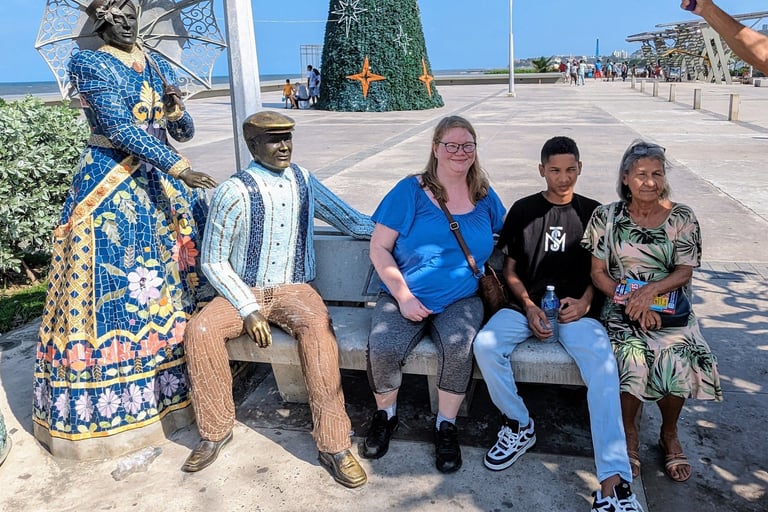

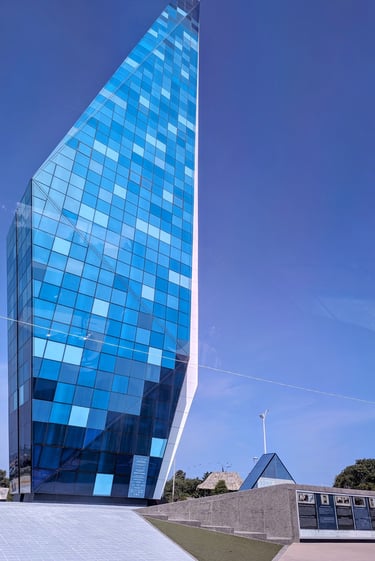

San Andres Island
After spending some time in Cartagena and going to Barranquilla to see my two sponsored "children" (now adults or practically adults), our next destination was the Caribbean island of San Andrés, a tiny island that belongs to Colombia but is a lot closer to Nicaragua. We were flying in the late afternoon from Cartagena Airport, so we had to check out of our Bocagrande hotel, leave our luggage in storage at the hotel and kill some time until it was time to go. We decided we'd go one last time to our favourite pub The Clock Pub in the Cartagena old town and pass the time eating lunch and having a few beers.

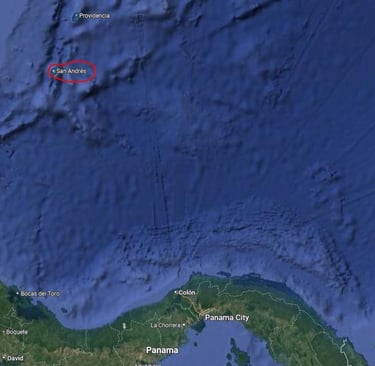
The location of the Colombian island San Andres is a lot closer to Nicaragua than it is to Colombia
As we sat at the pub enjoying our meal it started raining. We'd been particularly unlucky with the weather, as it was now January and the wet season is meant to be from April to November, but it had been raining about 80% of the time we had been in Colombia so far. The downpour caused people to escape indoors, including the pub that quickly filled up with customers. We had by this point finished our meal and were considering going back to Bocagrande to go and fetch our luggage but given the heavy rain, we were sure it would take us a while to get a taxi, while standing in the pouring rain, so we decided to wait a little longer until the rain quieted down a bit. Except it didn't. The heavy rain got heavier and it was not long until the staff members at the pub put up flood defences in the doorway of the pub, as the water level on the streets started rising to the point that we were now dealing with an actual flood. The old city's colonial-era infrastructure was not designed for modern urban runoff volumes, which can overwhelm the city's drainage systems. Turns out that stormwater drains and pumps are undersized, clogged, or outdated, especially in the historic center and some areas of the city rely on manual or temporary pumping during floods. The video below shows how it went from being dry to flooded within the course of more or less just 1 hour when we were there on the 4th of January 2025.

The flooding caused all traffic to come to a standstill and incredibly dirty water from overflowing drains, dirt from the street and possibly even sewage surrounded the pub, which we'd have to wade through if we were to get out of there. On top of that, a thunderstorm started, making it a terrible idea to be standing in water if a lighting struck. We decided we'd wait it out and hoped we'd manage to catch our flight, but it was becoming increasingly unlikely.
Eventually, the flood barriers of the pub couldn't hold anymore and people were asked to move to the second floor of the pub, as water started flowing into the ground floor. Soon after, we lost power and the waiting staff at the pub had to rush to get people's card payments for their bills while their POS machine was still running on battery. We phoned our hotel to ask how access was in Bocagrande and they said by this point the traffic was moving but very very slowly. By this point, we had given up hope that we'd make the flight. If the flight was even leaving in the first place, but online departure details suggested it was leaving on time. Apparently the airport doesn't have the same drainage issues as the old town and Bocagrande have.
We contemplated our choices - it looked like we'd lose out on our very expensive flight to San Andres and this night's accommodation. If we bought another flight, it would be expensive as well, but we'd also lose the other two nights' accommodation there as well as the flight from San Andres back to Bogota if we didn't buy another expensive ticket from Cartagena to San Andres. But also we wouldn't really have much time in the island at all if we did go - it had already been a short trip and it would be made even shorter. We considered just taking the hit and re-route direct to Bogota from Cartagena, but as this was holiday season in Colombia and it was last minute, the flights were super expensive to go there as well. The best thing that could happen to us was if the flight to San Andres was cancelled due to adverse weather, but unfortunately it wasn't.
The first thing we really needed to consider was to get accommodation in Cartagena for the night. We thought we'd go and get our luggage when the rain started to die down a bit, wading through the disgusting floodwater and eventually finding a taxi that would take us. The usually 10min trip took over an hour and the taxi driver was completely mental, breaking every traffic rule that exists. We got to the hotel, pretty shaken after the journey there, and got our bags. We asked if they had any rooms available for the night, but they said they were fully booked. We walked to several of the other nearby hotels asking if they had a room, and none did. We tried searching on Booking.com, Hotels.com and Airbnb but we had no luck, the only things that were available were outrageously expensive hotels costing hundreds of pounds for a night. We found some apartment for rent on Hotels.com which we booked but when we got there, there wa no sign for the flat, no access to the door and the owner didn't answer the phone. In the end, after much frustration, we booked the cheapest room we could find in Bocagrande, a room at the InterContinental at an outrageously expensive price for Colombia, at £192 GBP the night without breakfast. OUTCH.
Once we were able to get out of the rain and into our insanely expensive hotel (this was 250% more than we had paid at the OZ Luxury Hotel, the InterContinental room wasn't any better and OZ actually included breakfast for two), we were able to start making plans. In the end, we decided we'd just bite the bullet and buy another expensive flight to San Andres so that we wouldn't lose 2 more nights accommodation and the flight to Bogota, seeing as a flight to Bogota from Cartagena cost about as much as the flight to San Andres. So we booked another ticket through Kiwi.com (as the Colombian airline sites don't work for some reason unless you're willing to pay "tourist price" which is much more expensive). And then we just hoped that our travel insurance would cover these expenses as travel disruption (spoiler alert: THEY DIDN'T!).
My advice - avoid flying in the late afternoon, especially in the rainy season, as afternoon showers are common (though shouldn't have happened in dry season!). Also, if you do end up having a late afternoon flight, keep your luggage with you if you're going somewhere. If we had had ours, we'd have had a remote chance of catching our flight but the fact we first had to get to Bocagrande, and THEN go to the airport made it just impossible.
Next morning, we managed to get to San Andres without any issues. We flew with LATAM airlines and we were very impressed with the legroom actually! Joe always feels really cramped in jets but on the LATAM flight he had loads of space! So if you're one of those tall people who always feel uncomfortable on planes, we can recommend LATAM above any of the other airlines in Colombia.
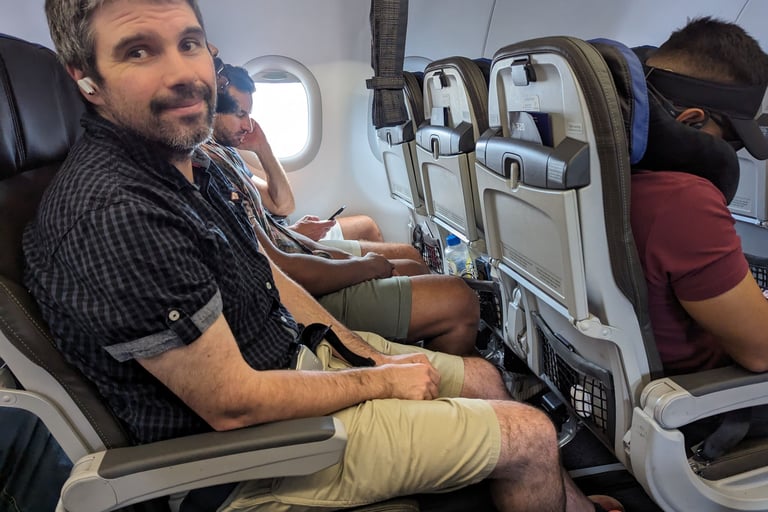

Joe feeling happy with plenty of legroom on the LATAM flight to San Andres Island
Before you ever board the plan to San Andres Island, you're required to pay for a tourist card to go there. When we were there in January 2025, it was $137,000 pesos per person and the price just keeps going up. You have to fill in the card but then when you land you also have to fill in additional paperwork, as if you were crossing an actual border (though you're still in Colombia!), so my advice is to take a pen with you or else you'll be waiting ages to get to use a "public pen".
It was quite curious landing in San Andres and in the arrivals hall you're faced with the Scottish flag (the flag of the St Andrews cross aka "San Andres" in Spanish). That is the flag of the island as well. I also don't know if this was on purpose or just a funny coincidence, but there was also an ad for Scottish whiskey in the same arrivals hall.
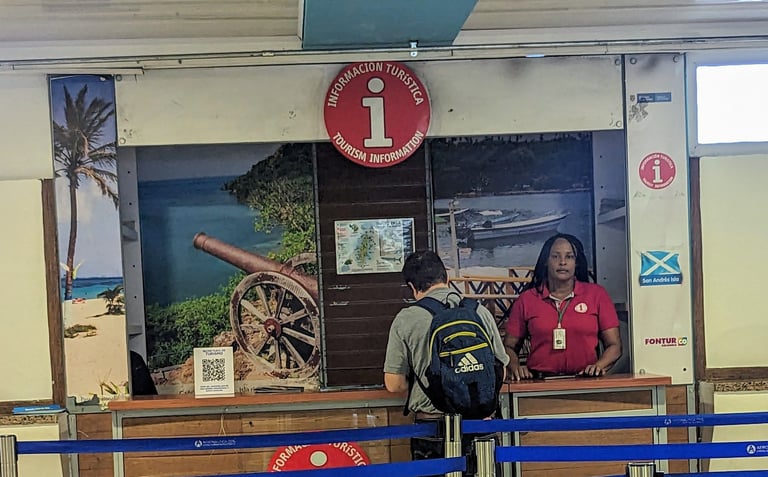

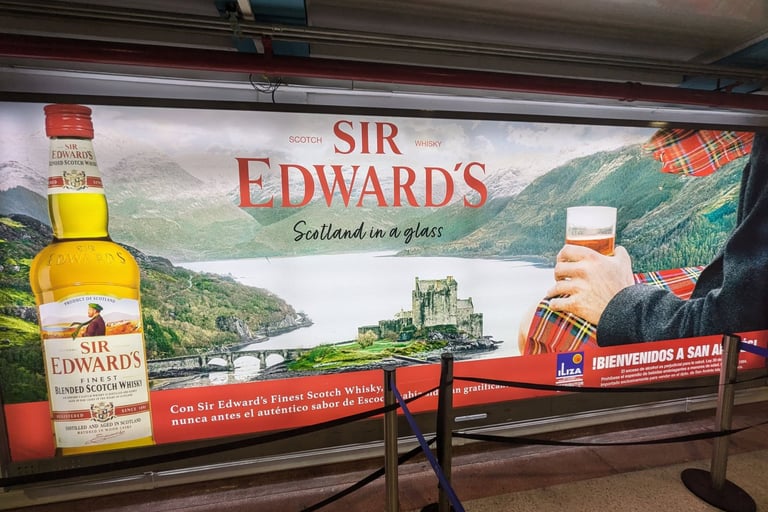

A weirdly Scottish-feeling welcome at the San Andres Island airport in Colombia
Apparently in the 17th century, British, Scottish, and Irish settlers, including Puritans and privateers, colonised parts of the Caribbean, including the San Andrés and Providencia islands. The Providence Island colony (1629–1641), which included San Andrés, was established by the English Puritan Providence Island Company. Scottish settlers were part of this movement. The islands were later claimed by Spain but remained heavily influenced by Anglo-Caribbean culture. From what we understand, San Andrés Island uses the St. Andrew’s Cross in its flag to honor its British colonial heritage and Protestant identity, not out of a connection to modern Scotland or Scottish nationalism. It’s a powerful cultural and historical symbol for the island’s Raizal population and their struggle to preserve autonomy and identity within Colombia.
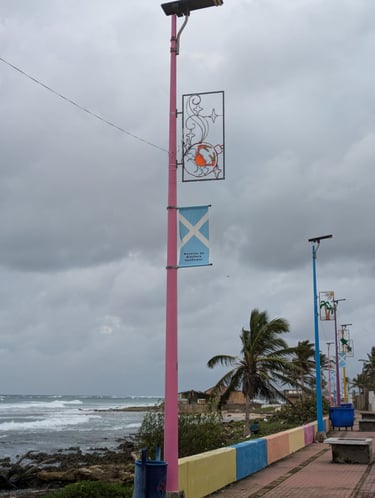

The Saltire flag is everywhere in San Andres
The people of San Andrés Island have a unique and vibrant culture shaped by a mix of African, European, and Indigenous influences. They are known for their warm hospitality, rich traditions, and strong sense of identity. The native inhabitants of San Andrés are known as the Raizal people, a predominantly Afro-Caribbean community. They are descendants of African slaves, British settlers, and Indigenous people from the Caribbean region. The Raizal people traditionally speak Creole English (San Andrés–Providencia Creole), a language that blends English with African and Caribbean influences. Spanish is also widely spoken due to the island’s affiliation with Colombia. The Raizal community has a strong religious heritage, primarily Protestant, with many belonging to the Baptist Church. This reflects the influence of British settlers and missionaries who arrived in the 17th and 18th centuries.
The people of San Andrés have a deep connection to the sea, as fishing has been a central part of their way of life for generations. Many families rely on fishing, tourism, and maritime trade for their livelihoods. Music is important in San Andrés, but calypso, reggae, soca, and dancehall are central to the island’s culture. Traditional dances like the mento and quadrille also often accompany local celebrations.
The Raizal community has faced challenges in maintaining their cultural identity due to increasing migration to the island, globalisation, and the dominance of Spanish as the national language. While tourism brings significant revenue to the island, many locals feel they do not benefit equally from the industry, with much of the profits going to outside investors. Overcrowding and the environmental impact of tourism pose challenges to the island’s natural resources and traditional way of life, however there are places you can go to escape the crowds if you stay away from San Andrés main town.
We ended up booking an AirBnB flat for £60 GBP/night in the village of San Luis to the south of San Andrés main town, which provides a quieter, more authentic experience of Raizal traditions and you can note a strong sense of community. It is a beachfront area known for its tranquil environment, colorful wooden houses, and a more relaxed, less touristy atmosphere. There are many small, family-run restaurants in San Luis that serve traditional dishes like rondón and coconut rice, offering an authentic taste of the island. There are also a number of beach pubs to enjoy the powdery sand and the inviting sea. We had a wee flat at our San Luis AirBnB but it wasn't quite as private as we thought when booking it, as the outdoor space on both sides is shared with the owners, and there's a door that links the main house to the guest flat which isn't very soundproof at all. However, it was a nice place to stay and catered to all our needs, conveniently located close to two beaches, a shop and a few restaurants.
We didn't have too much time in San Andrés but we did manage to visit the two beaches near our hotel (Playa San Luis and Playa Zarpada), as well as San Andrés main town. Of the beaches near us, I personally preferred Playa San Luis to the south of our flat. The sea was more inviting and the beach had less sea weed. We also enjoyed the cocktails served at the Playa Marrakech Club at the beach, where we got two cocktails for $65,000 pesos (£11.60 GBP).
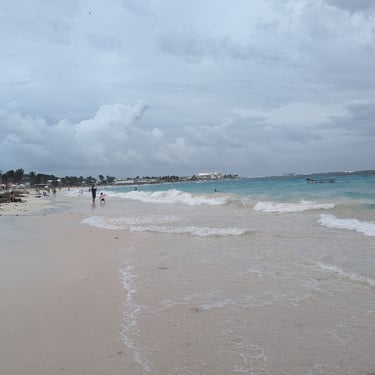
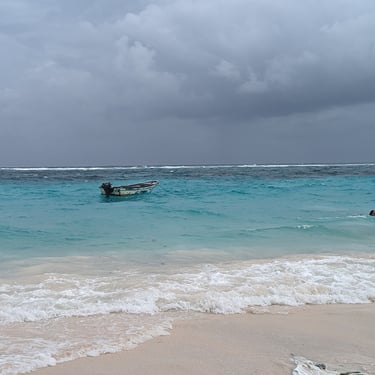
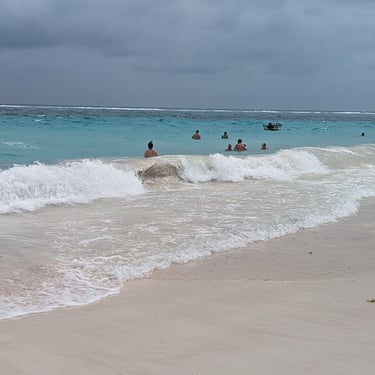
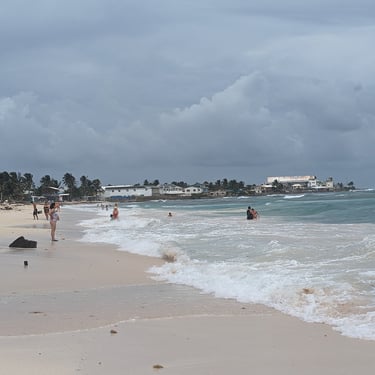
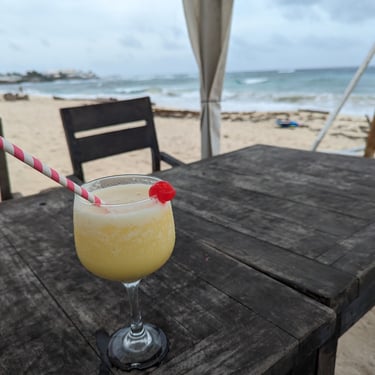
Playa San Luis to the south of our Airbnb
The walk to the beach took us about 10 minutes through some hurricane affected landscape, but San Andrés has suffered some serious hurricanes. Though it's relatively rare compared to other Caribbean locations, San Andrés Island has been hit by several significant hurricanes, with a few particularly destructive storms have directly or severely impacted the island in recent years. On 16th November 2020, a Category 5 Hurricane Iota approached San Andres, reaching land when it was a Category 4 hurricane. It was the worst hurricane in the island’s modern history. Iota also passed directly over Providencia Island (just 90 km from San Andrés) and caused devastating damage there, destroying nearly 98% of infrastructure and the island still hasn't recovered. In San Andrés Island there was widespread structural damage to buildings, hotels and homes as well as power outages, downed trees and flooding. The storm disrupted communications, transportation, and tourism infrastructure. Iota was part of the most active Atlantic hurricane season on record (2020). In early November 2020, just a couple of weeks before Iota, Hurricane Eta brought heavy rain and strong winds to San Andrés, causing flooding, coastal erosion and wind damage, leaving the island vulnerable to Iota that arrived 2 weeks later.
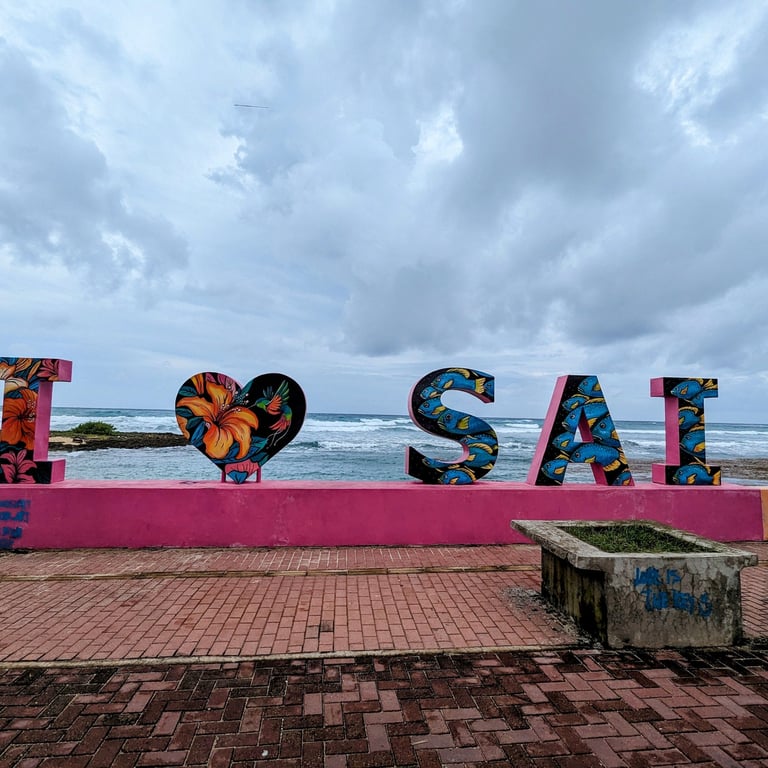
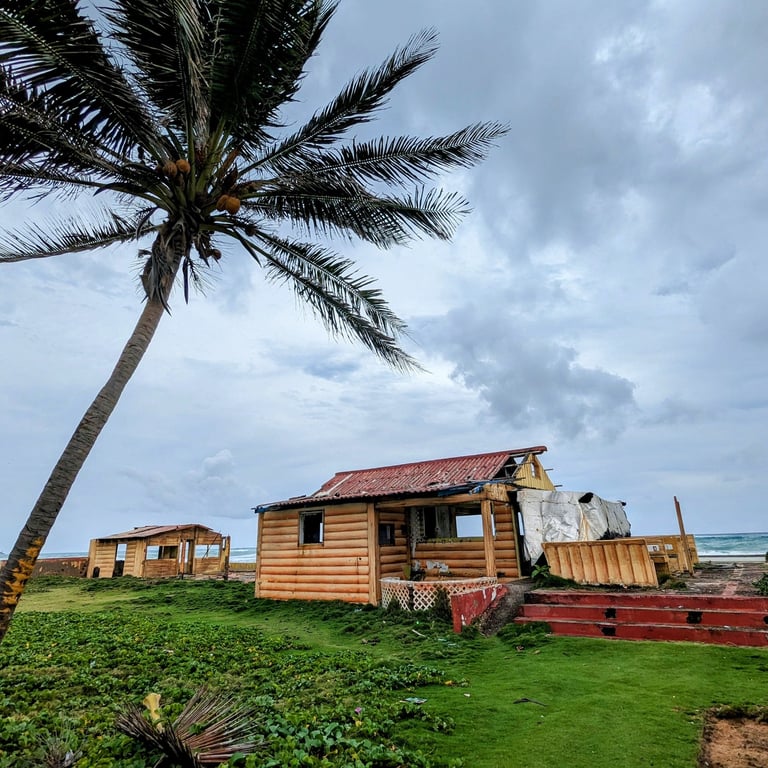

The coastal route from our Airbnb to Playa San Luis
We later went to Playa Zarpada, but our host said that was his favourite beach out of the two as it's better for swimming. The water at Playa San Luis is quite shallow. However, while the water is deeper at Playa Zarpada, and you also get a nice view there over to Rocky Cay (which you can also visit if you have time and weather allows), the sea was really quite full of seaweed which, when you have the seaweed wrapping itself around you, feels pretty gross and uncomfortable. My personal choice would be to spend more time at Playa San Luis, but unfortunately we didn't have time to go there a second time.
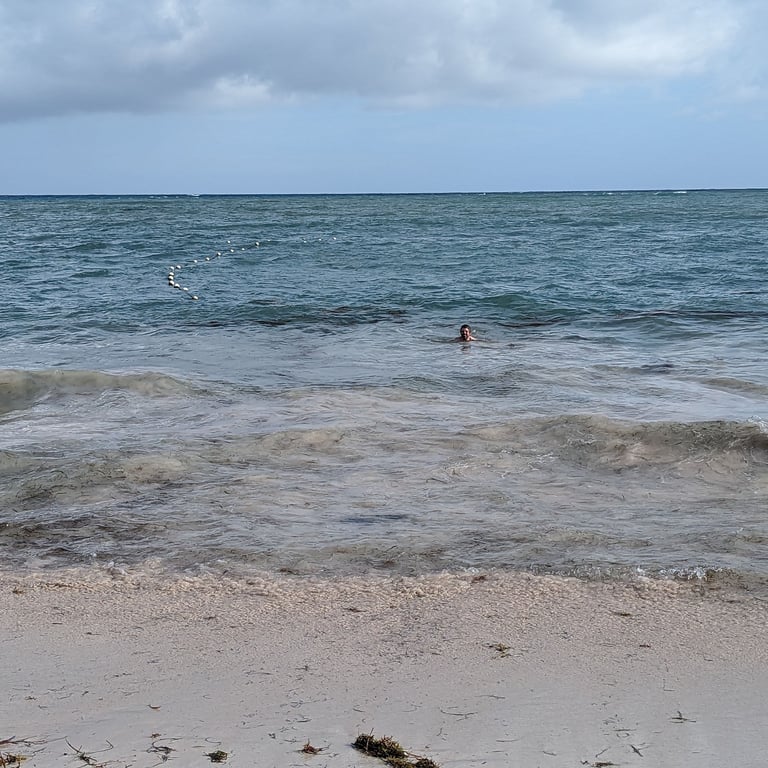
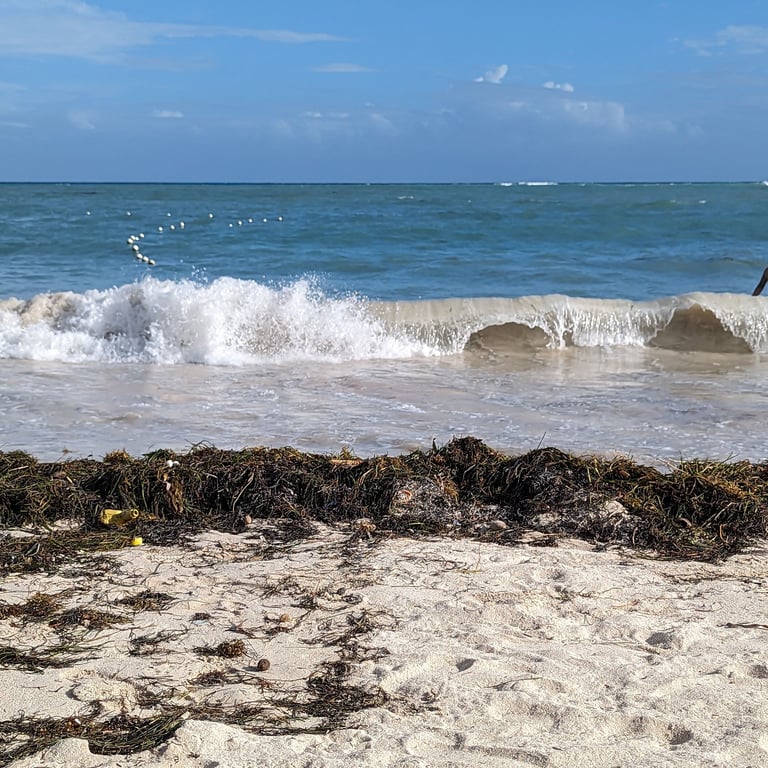
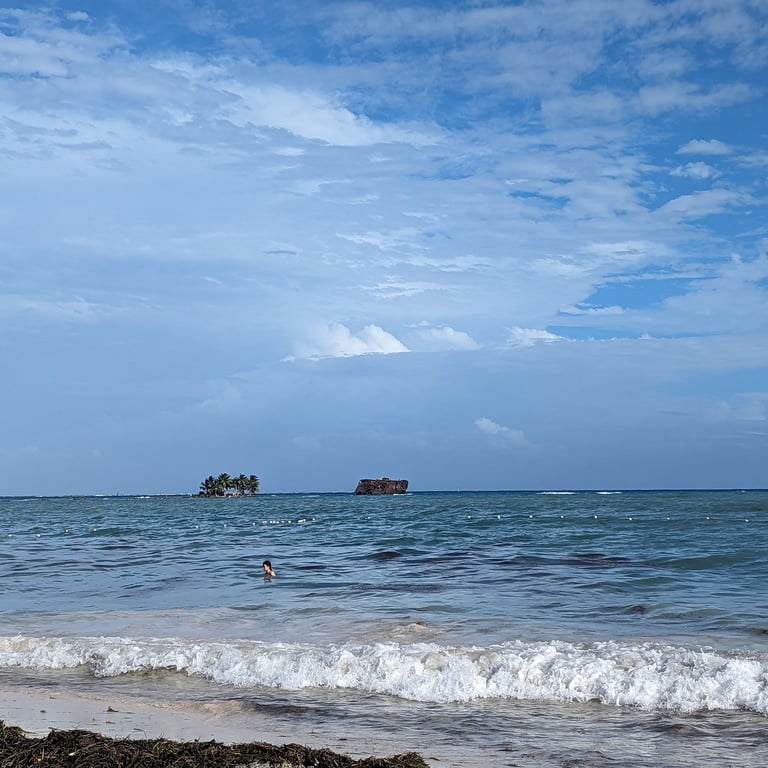
Playa Zarpada north of our Airbnb in San Luis on San Andres ISland. A lot more seaweed than at Playa San Luis.
On the second day we had in San Andres Island, we went by bus to the main town to see what the fuss was about (it gets incredibly crowded during peak season and is massively popular with Colombian travellers). The town itself was pretty quiet to be honest, at least during the day when we were there but we managed to find an open shop that sold us a magnet for our magnet collection. Obviously it had to be one that included the Saltire flag!
We then headed to the beach in town but it was getting very warm even though it was still practically the morning, and we were getting very thirsty for a beer! However, the bars and restaurants at the beach hadn't opened yet, even though there was already loads of people on the beach.
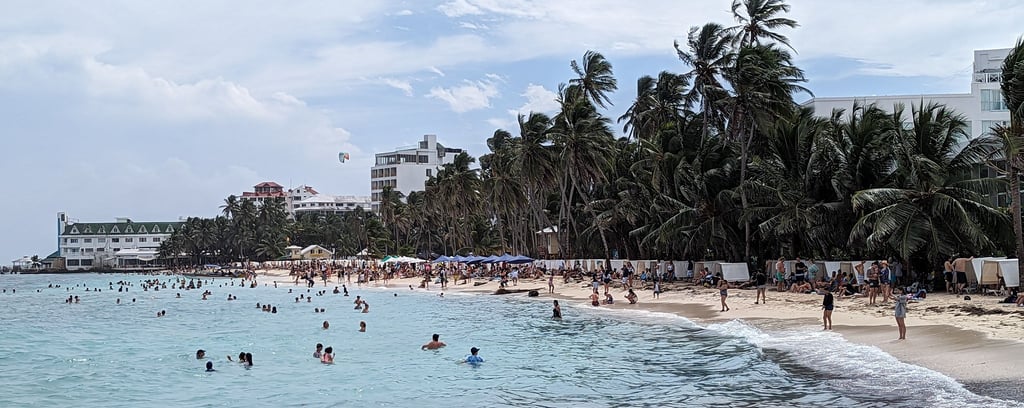

People taking advantage of Playa Spratt Bight beach in San Andres main town in the morning
We had our eye on a place called the Beer station where we wanted to have some drinks and lunch by the beach, but we had to hang around until it opened at midday. We had a 1.8L pitcher of the Honey Ale for $48,000 pesos (£8.60 GBP) and enjoyed the beautiful views over Playa Spratt Bight beach. I could see though why it's a popular place, as the beach is well maintained and the sea is incredibly inviting. I think though with a few nice touches, the Playa San Luis and Playa Zarpada beaches could be just as good.
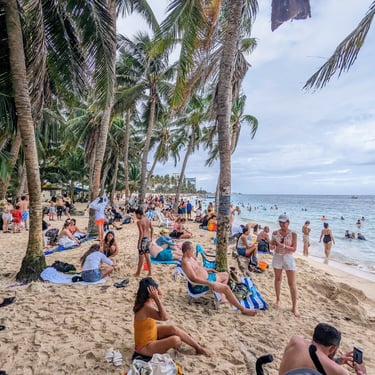
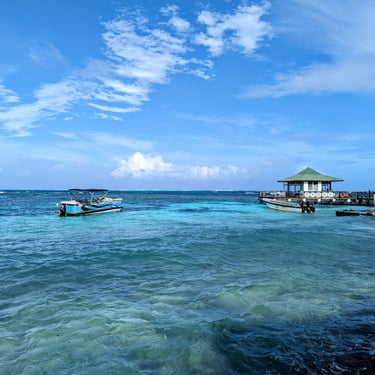
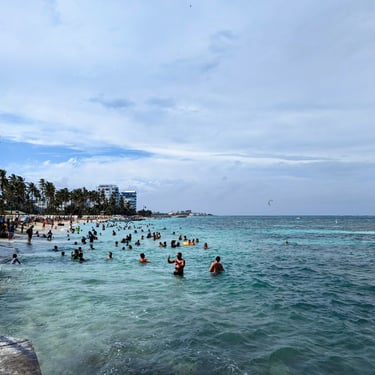
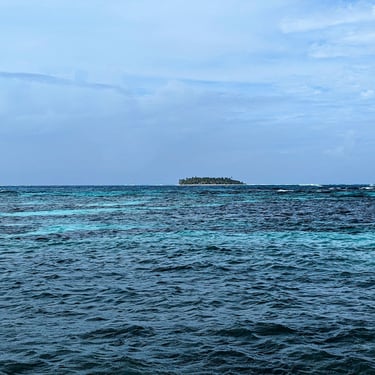
Playa Spratt Bight beach in San Andres Town is well maintained and the sea looks so inviting, but it is very busy
I really enjoyed our time on San Andres Island. I would have liked to have had more time, as I find the Afro-Caribbean culture fascinating and I would have liked to immerse myself more in it. It was such a curious place to be, being in Colombia but the place feels a world away. The vibe was definitely more Jamaica'esque and I would have loved to have more opportunity to try some of the local food, chat to the locals more and just generally experience more, as we just had a flying visit which was a very, very brief introduction to the island life. I would have also loved to have had the time and opportunity to visit Providencia Island and support the locals there who are still recovering from the 2020 hurricane, but the island is meant to be absolutely gorgeous. If you are in Colombia, I do recommend visiting the islands. Now, it was time for us to go to Bogota and then home.
Bogota - La Candelaria Neighbourhood
Our last stop on our Colombia tour was Bogotá. We had stayed in Salitre near the airport when we first arrived, simply because we had just come off a plane and were due to board another plane right the next day. However, to be able to actually see a bit of Bogotá itself, we decided to stay in the famous La Candelaria neighbourhood of the city on our last day in Colombia. La Candelaria is the historic heart of Bogotá and one of its most vibrant and culturally rich neighborhoods. The neighbourhood is known for its well-preserved colonial buildings, many of which date back to the 16th and 17th centuries. The narrow cobblestone streets, colorful facades, and wooden balconies transport visitors to Bogotá’s early days and walking around the neighbourhood is a joy. Whether you’re a history buff, art enthusiast, foodie, or simply looking to explore a vibrant and colorful neighborhood, La Candelaria has something for everyone and is a must-see for anyone visiting Bogotá. When we stayed there, we were staying in a lovely little AirBnB flat that had a roof terrace with stellar views over the city. It had everything we needed but only cost us £50 GBP for the night. Some of the pictures below show the view we got from the terrace.

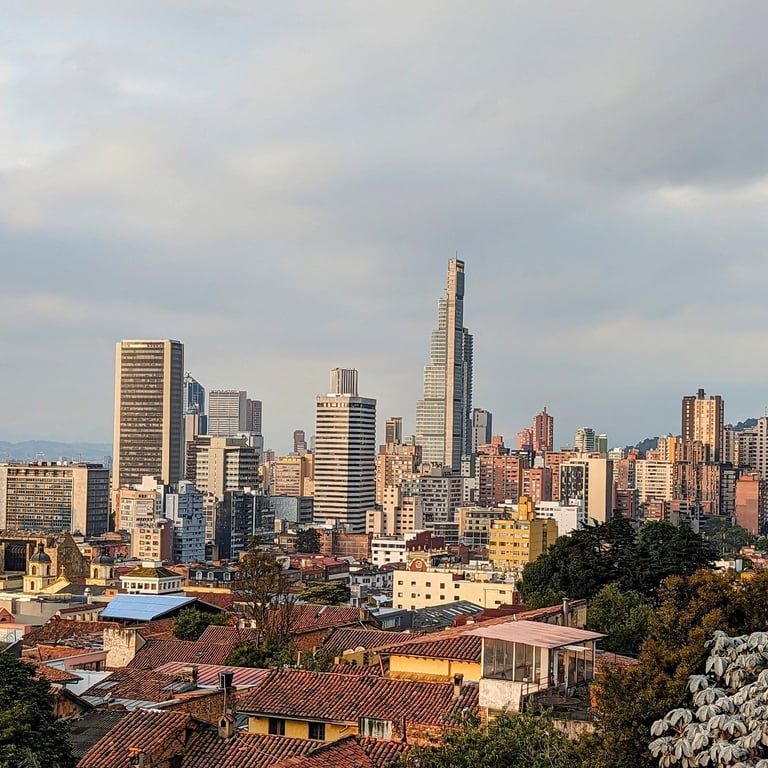
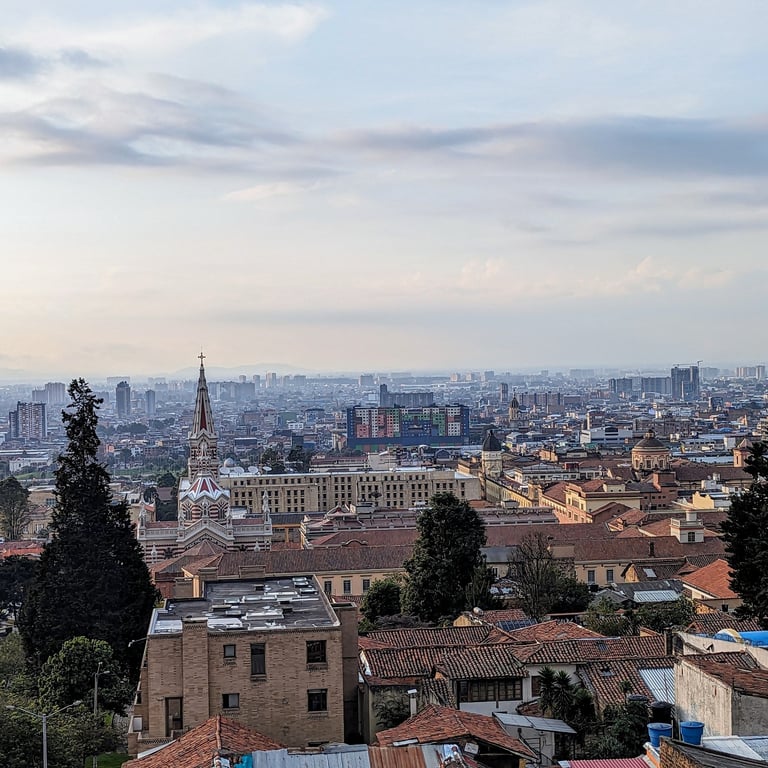
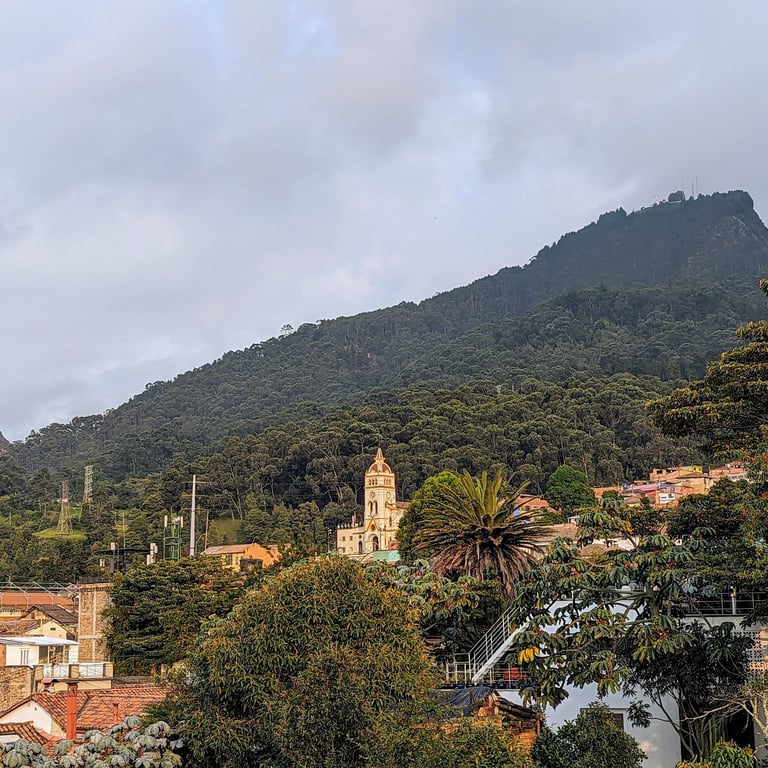
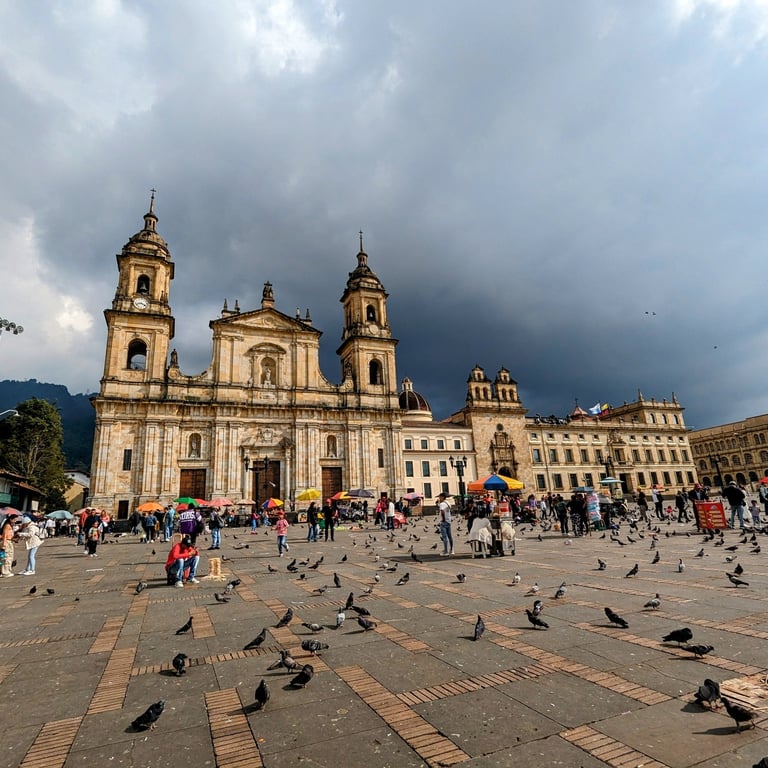
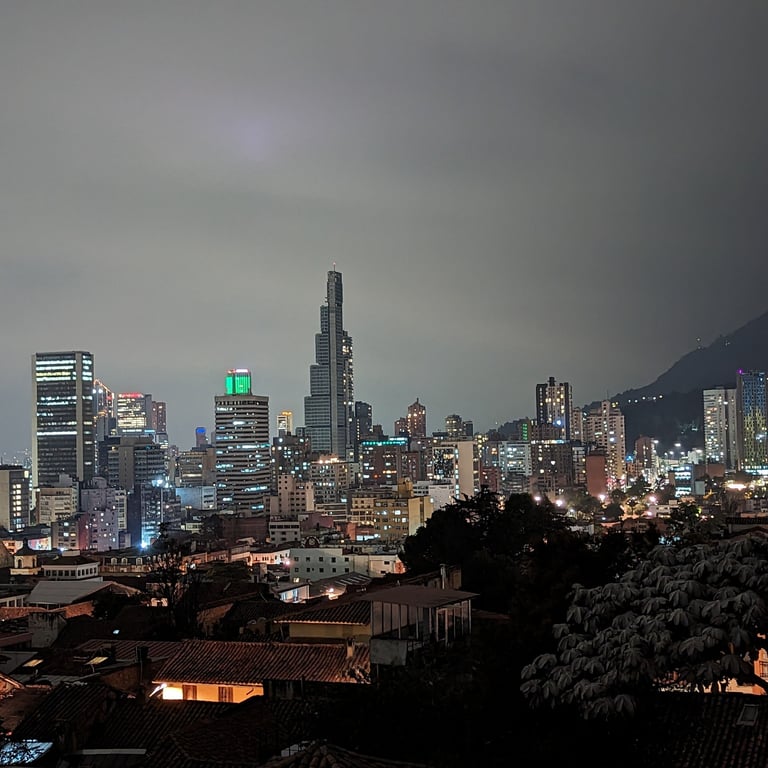
A few photos from around La Candelaria
Aside from the obvious charming architecture of the neighbourhood of La Candelaria, there are also a fair few attractions to visit as well. The ones we went to included:
Gold Museum (Museo del Oro): One of the world’s largest collections of pre-Columbian gold artifacts. It showcases the intricate craftsmanship of indigenous cultures.
Botero Museum: Houses works by Fernando Botero, Colombia’s most famous artist, known for his "voluminous" style, along with pieces by Picasso, Dalí, and others.
Casa de la Moneda: The old mint of Colombia, now a museum detailing the country’s numismatic history, located in the same building as the Botero Museum.
The Casa de Moneda we kind of just stumbled into, as it was free admission and we were already going to visit the Botero Museum. It wasn't terribly interesting (unless you're fascinated by old coins) but we had time to kill and it was interesting enough.
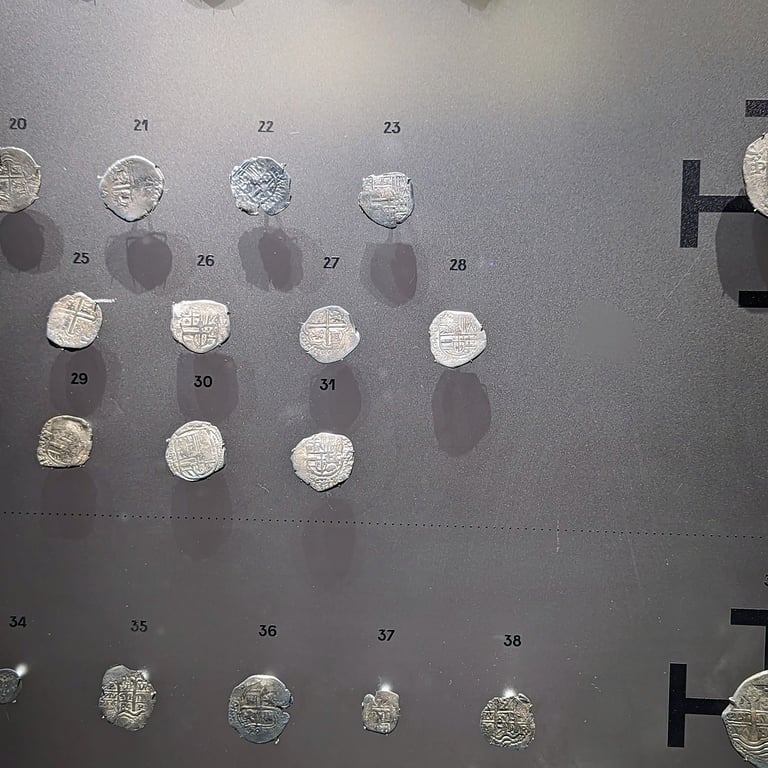
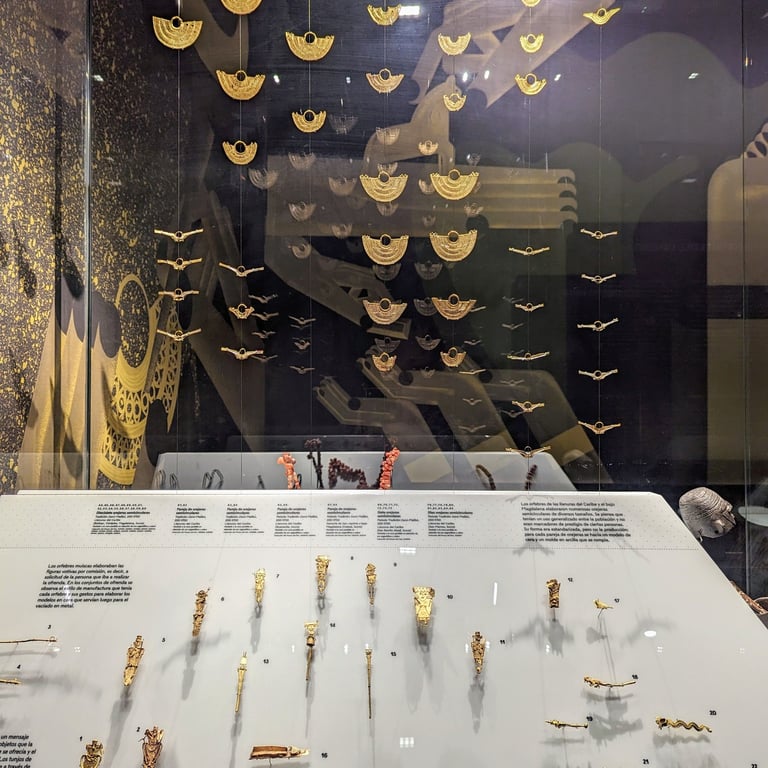
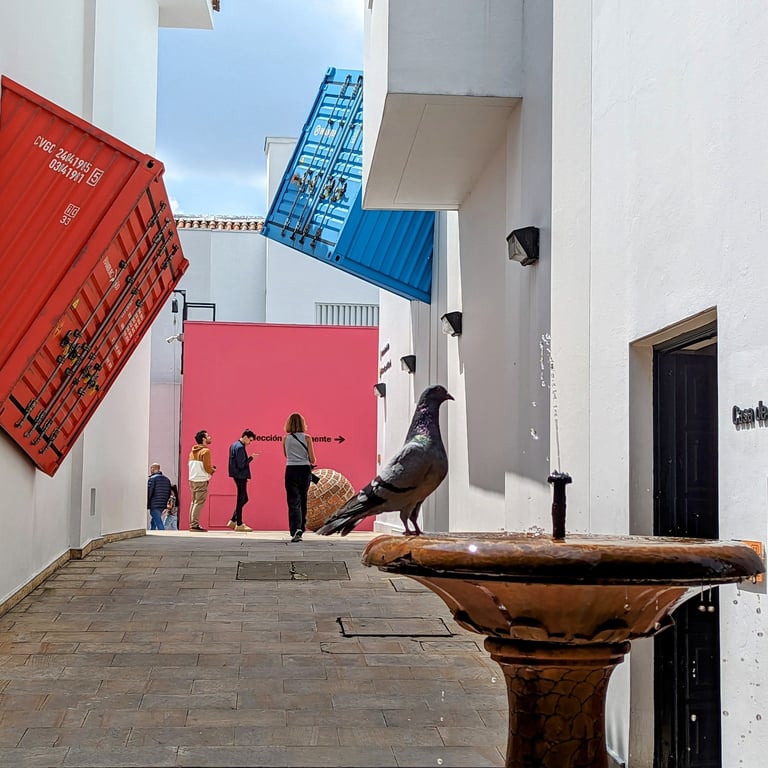
Museo Casa de Moneda in La Candelaria
However, the old building with its courtyards that houses both the Museo Botero and the Museo Casa de Moneda is absolutely beautiful.
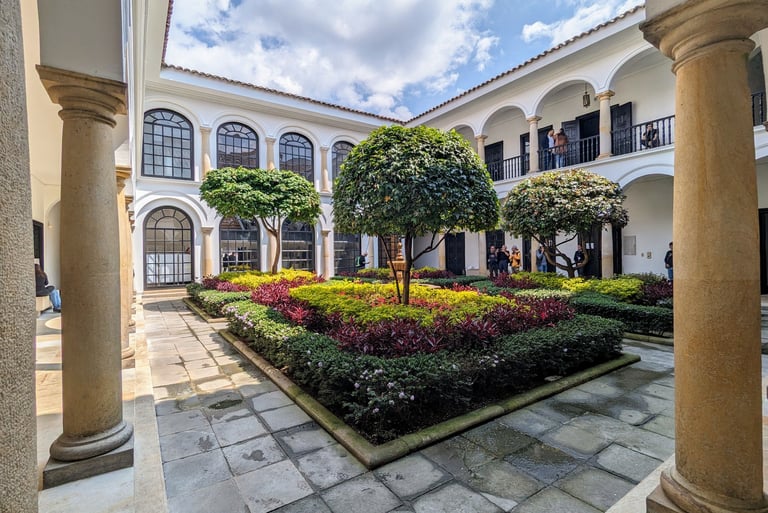

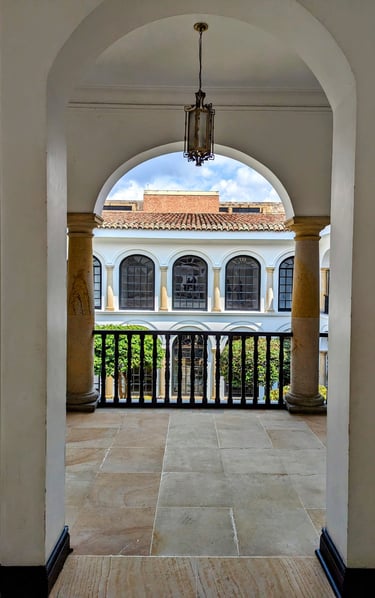

The building that houses Museo Botero and Museo Casa de Moneda
We made up for missing the Plaza Botero in Medellin by visiting the Museo Botero in La Candelaria. Fernando Botero (1932–2023) was one of Colombia’s most famous and internationally celebrated artists, known for his distinctive, voluminous style often called "Boterismo." His work is instantly recognizable for its exaggerated, inflated forms—whether portraying people, animals, or objects—and it blends humor, critique, and elegance in a way that's both accessible and deeply symbolic. Anyone, even people like me who generally don't enjoy looking at art, will enjoy visiting the museum, as the images are just so entertaining and wonderfully weird.
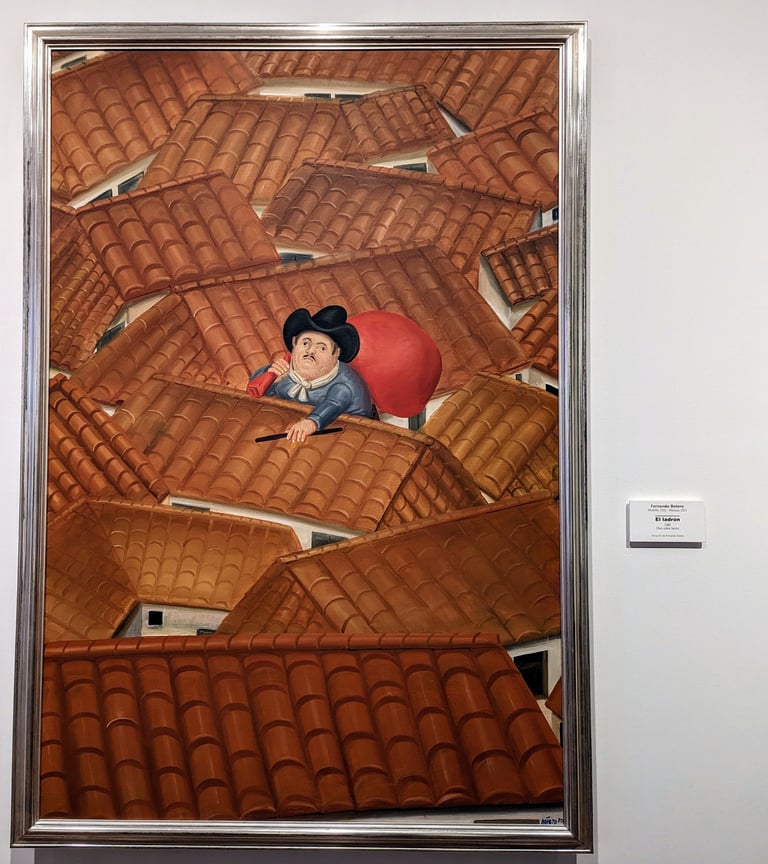
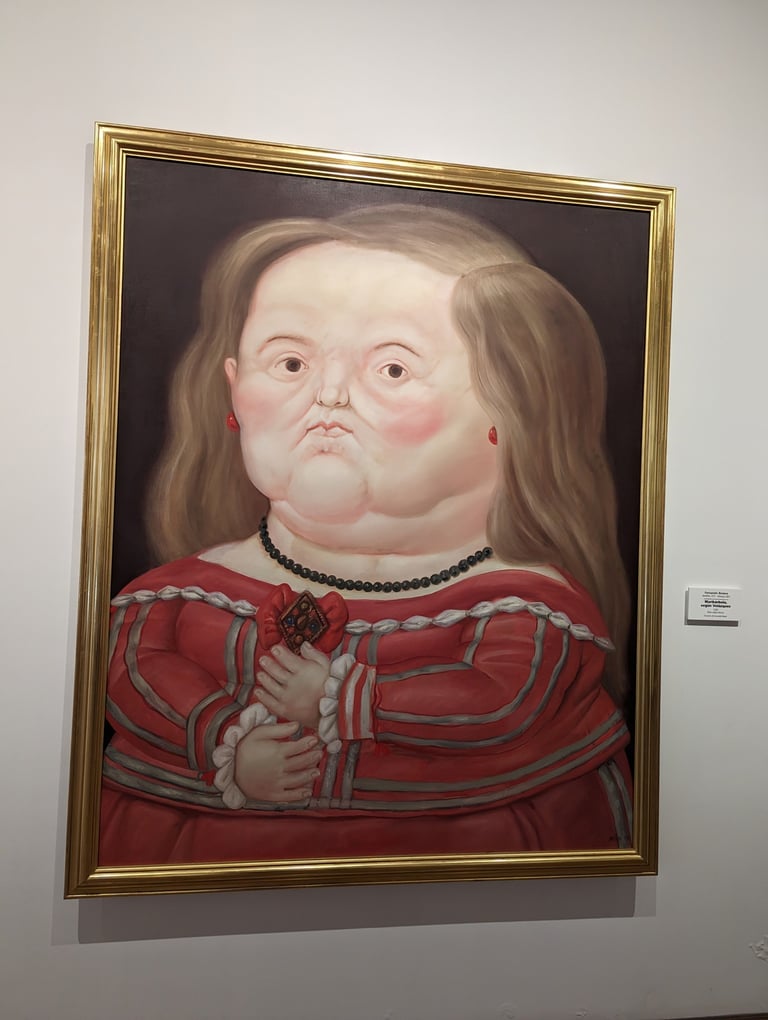
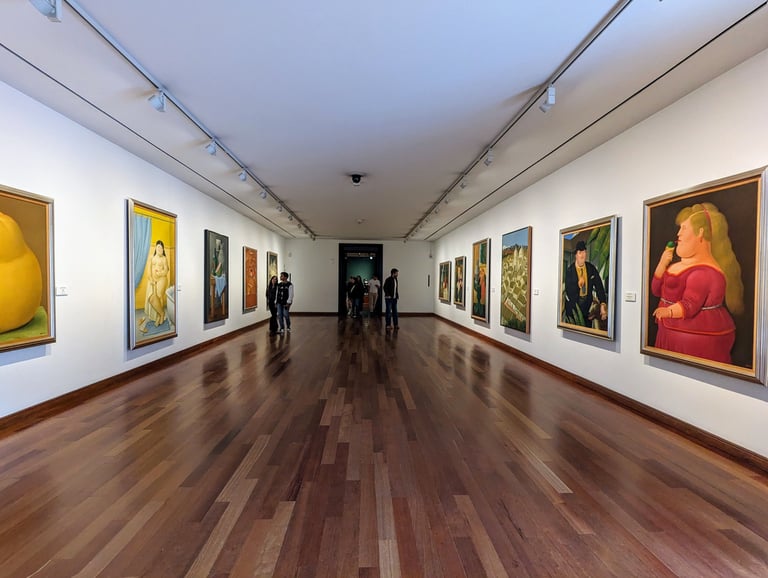
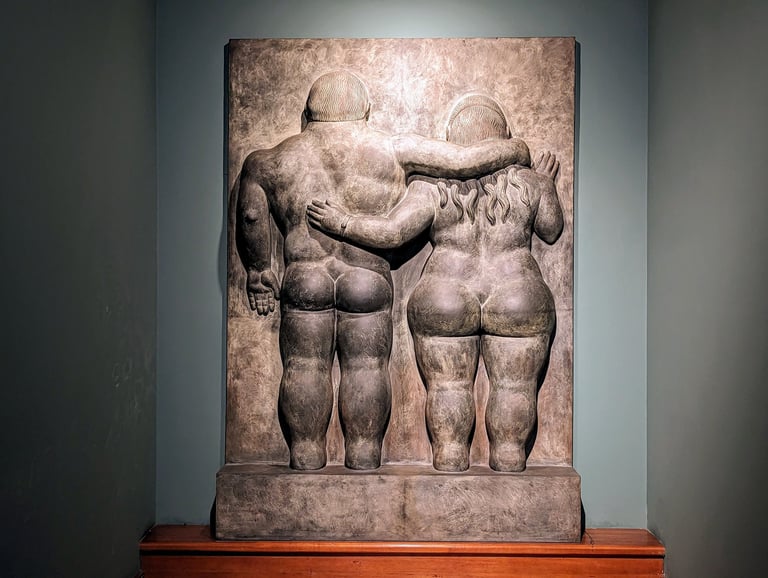
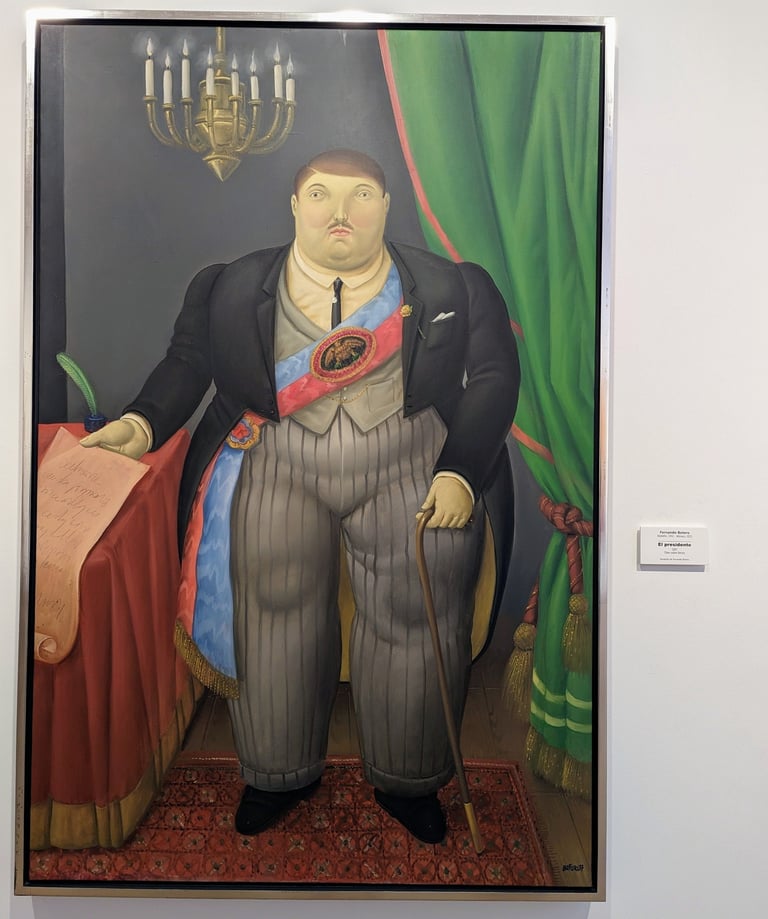
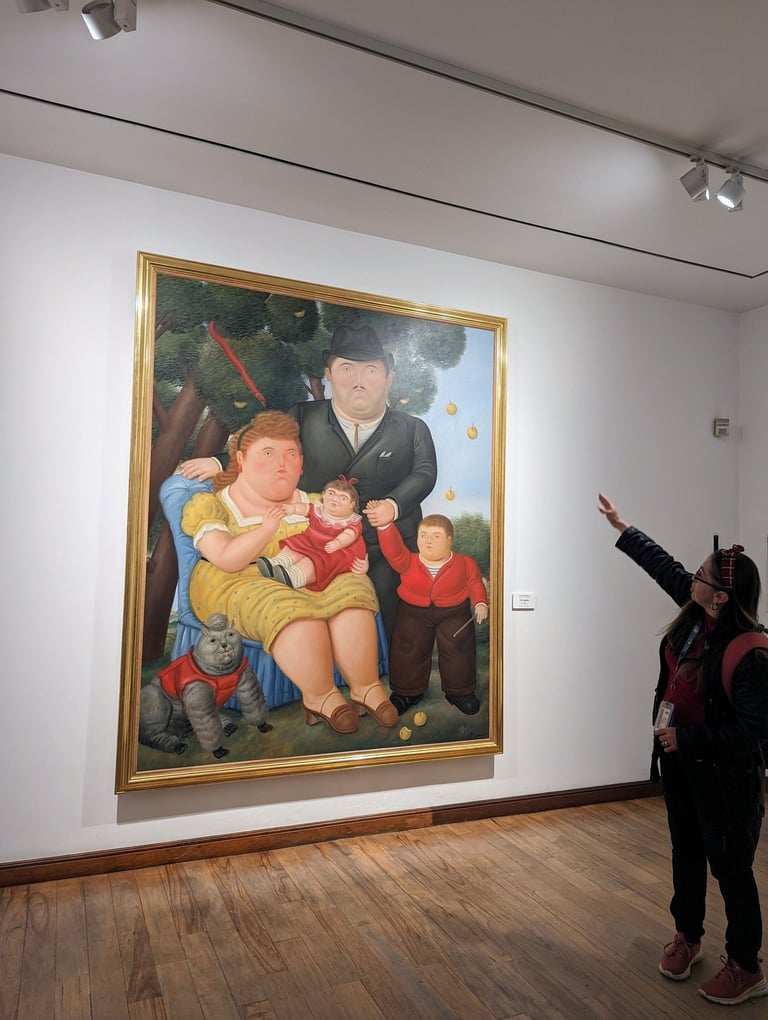






A few pictures from the Museo Botero in La Candelaria of Bogota
Then our very last stop on our La Candelaria tour of Bogota was to see the Gold Museum, which is another must-see when you're in Bogota. It is a world-renowned institution housing the largest collection of pre-Hispanic gold artifacts globally, with over 34,000 pieces on display.
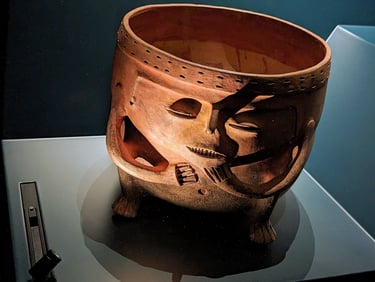
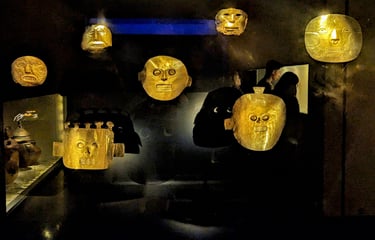
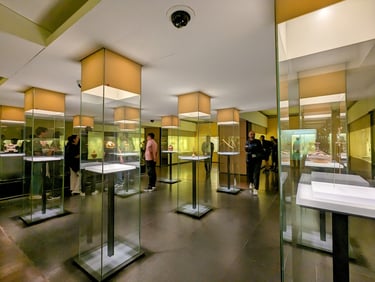
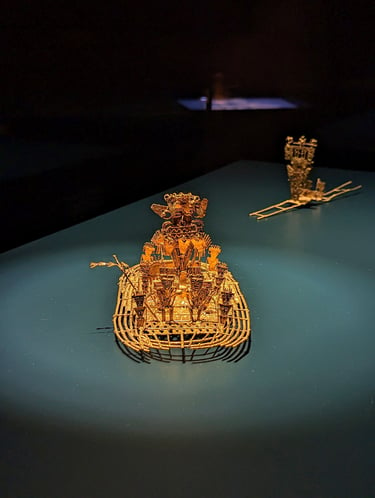
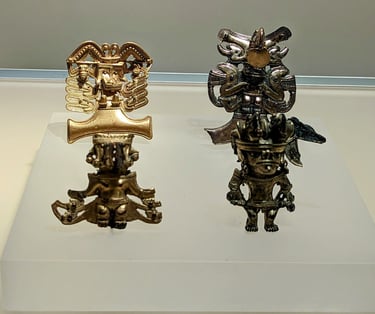
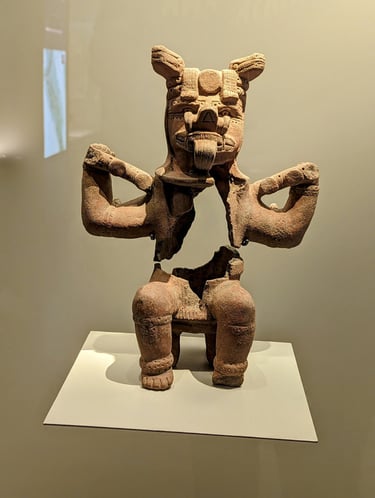
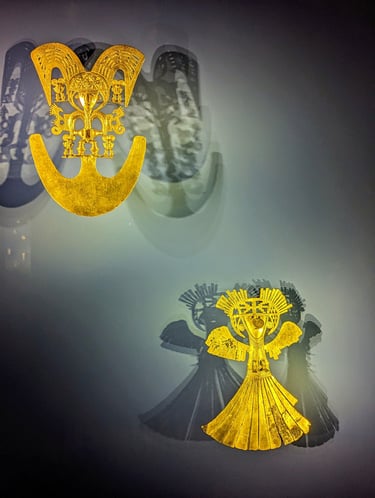
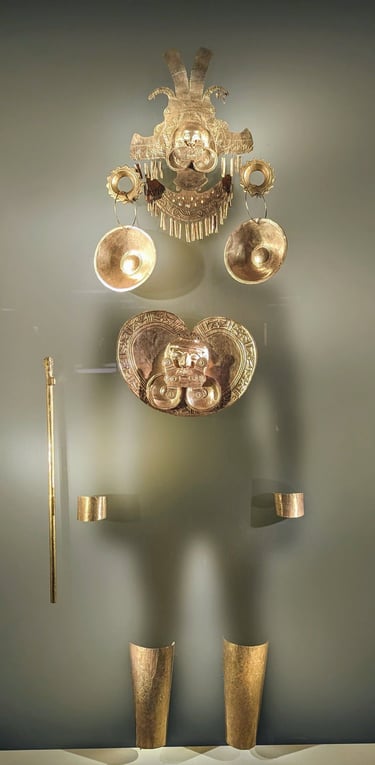








Some of the displays at the Museo de Oro (Gold Museum) of Bogota
Follow us on Social Media for travel updates and top tips!
© 2025. All rights reserved.
Find out about super-cheap flights and flight sales as soon as they happen from your home airport. Try 30 days for £1 GBP with 14 day money-back guarantee and cancel any time.
Click here for more information.

